Better Sailing
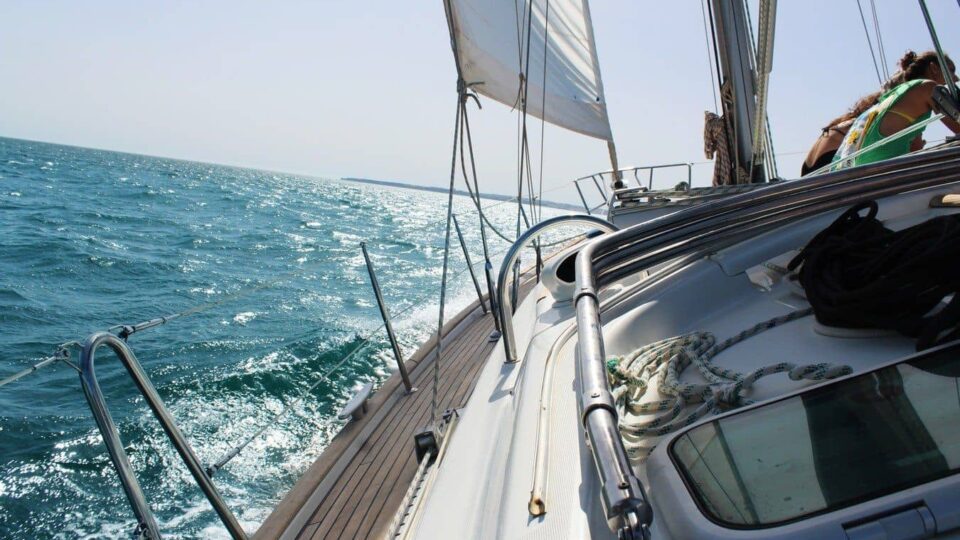

What is Sailboat Rigging?
The domain of rigging is an essential matter for the safety and good performance of your sailboat. Nowadays, the type of rigging is still evolving. Generally, rigging is depending on the type of sail used or the number of masts. As a basic rule, the replacement of the standing rig should be done every 10 years, except for multihulls or regattas, and rod or composite fiber rigging. A good set of rigging is of great importance in order to ensure navigation without causing any damage. A useful tip is to perform often thorough checks of the state of the rigging of your sailboat. Like this, you will prevent any possible damages from happening. So, let’s examine what exactly is sailboat rigging.
Standing and Running Rigging
Standing rigging supports your sailboat’s mast. The standing rigging consists of all the stainless steel wires that are used to support the mast. Moreover, standing rigging includes the rods, wires, and fixed lines that support the masts or bowsprit on a sailing vessel. In addition, all these reinforce the spars against wind loads transferred from the sails. On the other hand, running rigging is the rigging for controlling and shaping the sails on a sailboat. Running rigging consists of the main and jib sheet, the boom vang, the downhaul, and the jib halyard.
The subdivision of running rigging concerns the jeers, lifts, and halyards (halyards). This supporting equipment raises or lowers the sails and also controls the lower corners of the sails, i.e. the tacks and sheets. Over the centuries and up until nowadays, the history of sailboats rigging is still developing. What we’ve learned by now is that the combination of square and fore-and-aft sails in a full-rigged ship creates a highly complex, and mutually reliant set of components.
Wire Rigging
Wire rigging is the most common form of standing rigging on sailboats today. Furthermore, the style of the wire used is made of stainless steel, which is also a common wire style. What is advantageous with wire is that it’s quite affordable, especially when using swage fittings. The wire has also a long life expectancy, about 10 to 20 years, depending on use and the region you’re sailing to. However, wire rigging is more elastic than rod and synthetic rigging, thus it offers the lowest performance.
Rod Rigging
The rod rigging composition is of high-quality materials that provide low stretching. Moreover, it has a very long lifespan and great breaking strength, much more than that of its wire counterpart. Its life expectancy is attributed to the design, which is a mono strand, as well as to its composition that makes it very corrosion resistant.
Synthetic Rigging
Synthetic rigging is a new type of rigging and just like a rod, has minimum breaking strength. Nowadays, synthetic rigging offers low stretch performance features (that may vary depending on construction type), which are quite good for sailboats, among others. However, synthetic rigging will not last as long as the metal components. Most of the time, metal wire and rod are far better than synthetic rigging.
Based on the two rig types which are square-rigged and fore-and-aft, let’s divide the fore-and-aft rigs into three groups:
- Lateen Rig has a three-sided mainsail on a long yard.
- Bermuda rig which has a three-sided mainsail.
- Gaff rig is the head of the mainsail and has a four-sided mainsail.
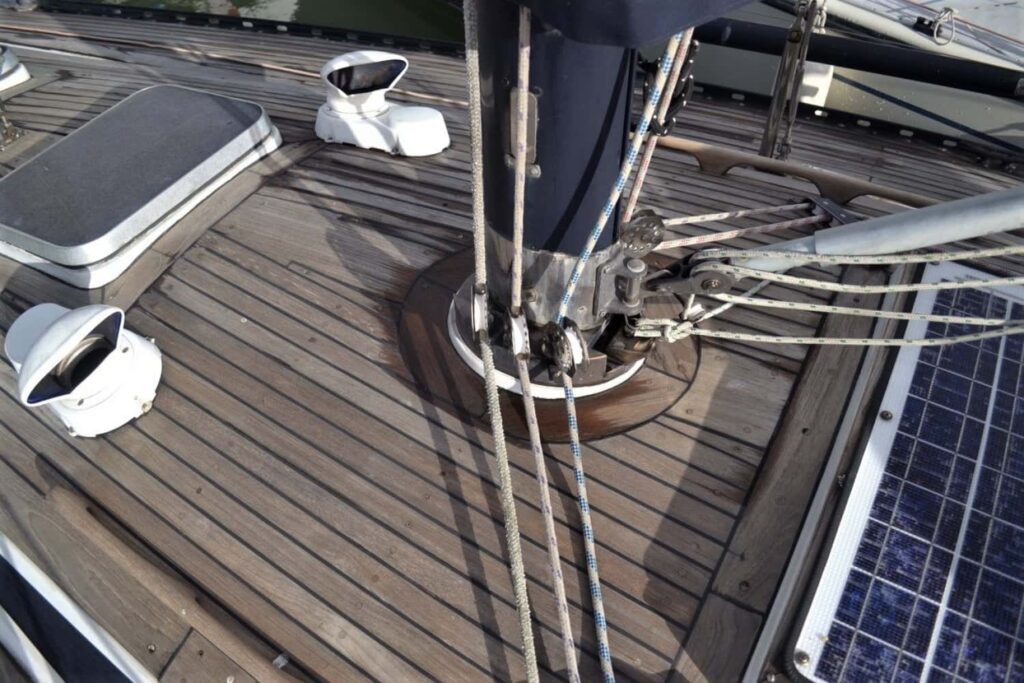
Parts of a Sailboat Rigging and Terminology
Cruising sailboats will usually have their mast supported by 1 x 19 stainless steel wire. However, there are some racing sailboats that may choose rod rigging. Why? That’s because rod rigging has a stretch coefficient that is some 20% less than wire. The downside is that it’s more difficult to install and adjust, as well as less flexible with a shorter life span. So, let’s move on and see the parts of the sailboat’s rigging and their terminology:
- Forestay and Backstay : Forestay and backstay support the mast fore and aft. The forestay keeps the mast from falling backward. It attaches at the top of the mast. The backstay is important for the sail’s control because it directly affects the headsail and mainsail.
- Cap Shrouds and Lower Shrouds : These parts hold the mast steady athwartship. The shrouds are attached to the masthead and via chainplates to the hull. Moreover, forward and aft lower shrouds provide further support. The lower shrouds are always connected to the mast, just under the first spreader, and at the other end to the hull.
- Spreaders : In general, spreaders keep the shrouds away from the mast. What is of high importance, in terms of stability, is their length and fore-and-aft angle. The rigs of cruising boats may have up to three pairs of spreaders, depending on a number of factors such as the sailboat’s size and type. Keep in mind that the more spreaders a sailboat has then the lighter the mast section can be. Last but not least, the spreaders must be robust in order to withstand the compression loads of the shrouds.
- Masts and Booms : Masts are tall spars that carry the sails, navigate the sailboat, and control its position. Sailboat booms are horizontal spars to which the foot of a sail is bent. The booms attach to the lower part of the mast. There are some sailboats with unstayed masts, like the junk rig and catboat rigs. They have no standing rigging at all, and neither stays to support them. For example, a Bermuda rig has a single mast and just one headsail, thus a relatively simple rigging layout. On the other hand, schooners or ketches have a really complex rigging, i.e. with multi-spreader rigs. Apparently, the mast on a sailboat is an important component.
- Chainplates, Toggles, and Turnbuckles : These important components of sailboat rigging attach the shrouds to the hull. The chainplate is a metal plate that fastens to a strong point in the hull. Toggles are comprised of stainless steel fittings that absorb non-linear loads, located between the shrouds and the chainplate. Turnbuckles (or rigging screws) are also stainless steel materials that allow the shroud tension to adjust better.
- Parts of Running Rigging : As mentioned above, running rigging has to do about shaping, supporting, and stabilizing the sails on a sailing boat. Therefore, the necessary materials for running rigging are numerous and need further explanation. Some of these materials are: The topping lifts, the halyards, the outhauls and downhauls, the boom vangs, the sheets, and more.
Sailboat Rigging – Summary
So, what is sailboat rigging? Sailboat rigging concerns the wires, lines, and ropes that hold the rig and control the sails. To be more accurate, this means the tensioned stays and shrouds that support the mast. Rigging has to do about the booms, masts, yards, sails, stays, and cordage. Same way with cars, sailboats also have an engine, but in the form of sails. This is the standing and running rigging. When we refer to standing rigging this means that the stays and shrouds are supported by the mast. On the other hand, running rigging refers to rope halyards, sheets, and other control lines. Depending on the type of your sailboat, this sail-engine might be old, new, or maybe somewhere in between.
Peter is the editor of Better Sailing. He has sailed for countless hours and has maintained his own boats and sailboats for years. After years of trial and error, he decided to start this website to share the knowledge.
Related Posts

Sailing with Friends: Tie Knots, Navigate the Seas and Create Unforgettable Memories
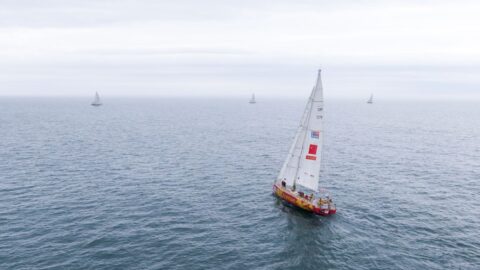
Atlantic vs Pacific: Which is More Dangerous for Sailing?

Lagoon Catamaran Review: Are Lagoon Catamarans Good?
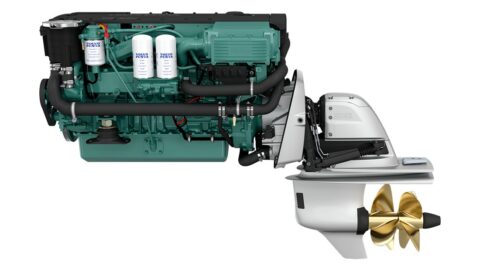
Best Inboard Boat Engine Brands
- Buyer's Guide
- Destinations
- Maintenance
- Sailing Info
Hit enter to search or ESC to close.
No products in the cart.
Sailing Ellidah is supported by our readers. Buying through our links may earn us an affiliate commission at no extra cost to you.
The Running Rigging On A Sailboat Explained
The running rigging on a sailboat consists of all the lines used to hoist, lower, and control the sails and sailing equipment. These lines usually have different colors and patterns to easily identify their function and location on the vessel.
Looking at the spaghetti of lines with different colors and patterns might get your head spinning. But don’t worry, it is actually pretty simple. Each line on a sailboat has a function, and you’ll often find labels describing them in the cockpit and on the mast.
In this guide, I’ll walk you through the functions of every component of the running rigging. We’ll also look at the hardware we use to operate it and get up to speed on some of the terminology.
The difference between standing rigging and running rigging
Sometimes things can get confusing as some of our nautical terms are used for multiple items depending on the context. Let me clarify just briefly:
The rig or rigging on a sailboat is a common term for two parts, the standing , and the running rigging.
- The standing rigging consists of wires supporting the mast on a sailboat and reinforcing the spars from the force of the sails when sailing. Check out my guide on standing rigging here!
- The running rigging consists of the halyards, sheets, and lines we use to hoist, lower, operate and control the sails on a sailboat which we will explore in this guide.
The components of the running rigging
Knowing the running rigging is an essential part of sailing, whether you are sailing a cruising boat or crewing on a large yacht. Different types of sailing vessels have different amounts of running rigging.
For example, a sloop rig has fewer lines than a ketch, which has multiple masts and requires a separate halyard, outhaul, and sheet for its mizzen sail. Similarly, a cutter rig needs another halyard and extra sheets for its additional headsail.
You can dive deeper and read more about Sloop rigs, Ketch Rigs, Cutter rigs, and many others here .
Take a look at this sailboat rigging diagram:
Lines are a type of rope with a smooth surface that works well on winches found on sailboats. They come in various styles and sizes and have different stretch capabilities.
Dyneema and other synthetic fibers have ultra-high tensile strength and low stretch. These high-performance lines last a long time, and I highly recommend them as a cruiser using them for my halyards.
A halyard is a line used to raise and lower the sail. It runs from the head of the sail to the masthead through a block and continues down to the deck. Running the halyard back to the cockpit is common, but many prefer to leave it on the mast.
Fun fact: Old traditional sailboats sometimes used a stainless steel wire attached to the head of the sail instead of a line!
Jib, Genoa, and Staysail Halyards
The halyard for the headsail is run through a block in front of the masthead. If your boat has a staysail, it needs a separate halyard. These lines are primarily untouched on vessels with a furling system except when you pack the sail away or back up. Commonly referred to as the jib halyard.
Spinnaker Halyard
A spinnaker halyard is basically the same as the main halyard but used to hoist and lower the spinnaker, gennaker, or parasailor.
The spinnaker halyard is also excellent for climbing up the front of the mast, hoisting the dinghy on deck, lifting the outboard, and many other things.
A sheet is a line you use to control and trim a sail to the angle of the wind . The mainsheet controls the angle of the mainsail and is attached between the boom and the mainsheet traveler . The two headsail sheets are connected to the sail’s clew (lower aft corner) and run back to each side of the cockpit.
These are control lines used to adjust the angle and tension of the sail. It is also the line used to unfurl a headsail on a furling system. Depending on what sail you are referring to, this can be the Genoa sheet , the Jib sheet , the Gennaker sheet , etc.
The outhaul is a line attached to the clew of the mainsail and used to adjust the foot tension. It works runs from the mainsail clew to the end of the boom and back to the mast. In many cases, back to the cockpit. On a boat with in-mast furling , this is the line you use to pull the sail out of the mast.
Topping lift
The topping lift is a line attached to the boom’s end and runs through the masthead and down to the deck or cockpit. It lifts and holds the boom and functions well as a spare main halyard. Some types of sailboat rigging don’t use a topping lift for their boom but a boom vang instead. Others have both!
Topping lifts can also be used to lift other spars.
A downhaul is a line used to lower with and typically used to haul the mainsail down when reefing and lowering the spinnaker and whisker poles. The downhaul can also control the tack of an asymmetrical spinnaker, gennaker, or parasailor.
Tweaker and Barber Haul
A tweaker is a line, often elastic, attached to the sheet of a headsail and used to fine-tune the tension on the sheet.
Barber haul
A barber haul is a line attached to a headsail’s sheet to adjust the sheeting angle to the wind. It is often used to pull the clew further toward the center or outboard than the cars allow.
Boom Preventer
A boom preventer is a line attached to the boom’s end when sailing off the wind. Its function is to hold the spar in place and prevent it from swinging wildly.
If the boat were to get an accidental gybe, it could cause serious damage to the rigging or even harm people on board. It is important for the rigger to be cautious when setting up the boom preventer.
Running Backstay
Running backstays is similar to a normal backstay but uses a line instead of a hydraulic tensioner. Some rigs have additional check stays or runners as well.
Bonus tip: Reefing
The term reefing is used when reducing the effective sailing area exposed to the wind of a given sail. Headsails are usually reefed by partially furling them in, and they often have marks for what we refer to as 1st, 2nd, and 3rd reefs.
The mainsail is reefed similarly with an in-mast furling or in-boom furling system.
On a traditional mast, we use a system called slab reefing. The system has reefing lines running through the boom to reinforced points on the luff and leech, allowing you to pull the sail down to the boom and effectively reduce the sail area.
Having at least two reefing points in the mainsail is normal, but most cruising sailboats have 3. The 3rd is used for the heaviest conditions, giving you only a tiny bit of sail area exposed to the wind.
You want to reef your sails before the wind increases to a point where your boat gets overpowered.
It is essential to practice your reefing technique . You will find yourself in situations with rapidly increasing winds where you need to reduce your sails quickly.
Rule of thumb: If you think setting a reef might be a good idea, do it.
Shaking a reef is the term used when we sail with a reefed sail and want to increase the sail area back to full.
Hardware used for sail handling and the running rigging
Furling system.
Most sailboats have their headsail on a furling system. A furling system is a tube that runs along the forestay from the bottom furler drum to the masthead swivel.
This system allows you to roll the headsail around the forestay, making furling the sail in and out accessible. It is also convenient when reefing the sail when the wind picks up, as you can easily do this from the safety of the cockpit. These furling systems come in manual versions and electric versions.
In-mast furling
In-mast furling is a system that rolls the mainsail in and out of the mast. To unfurl the mainsail, we use the outhaul .
In-boom furling
In-boom furling is a system that rolls the mainsail in and out of the boom. This system has been costly and has mostly been seen on big yachts earlier. They are becoming more affordable and common on smaller boats, though. To unfurl this setup, we use the main halyard.
A Stack pack is also called a Lazy Bag or Lazy Pack. It is a bag with a zip attached to the boom where the mainsail is stored when unused. It protects the mainsail from UV rays from the sun and weather elements. It is a very nice and tidy way to store the mainsail and reefing lines if you don’t have in-mast or in-boom furling.
Lazy Jacks is a system of lines running from the stack pack to the mast. The Lazy Jacks guide the mainsail up and down from the Stack Pack and prevent it from falling down on the deck. It is also possible to rig Lazy Jacks without a Stack Pack.
A block is a pulley with a sheave wheel. Blocks are used to change the direction of a pull on a line or rope and give a mechanical advantage. They have many uses, especially onboard sailboats.
A winch is a metal drum that gives you a mechanical advantage to control and tighten lines. These can be operated by turning a rope around it and pulling manually or by a winch handle to get more force. Most modern winches are self-tailing, which means they lock the line on so you can winch the line without holding on to it. Some boats even have electrical winches operated by a button.
Mainsheet Traveler
The mainsheet traveler is a horizontal track that the mainsheet is attached to through a series of blocks. The traveler enables you to adjust and lock the boom at an angle and also plays a critical part in trimming the mainsail.
Most cruising sailboats have their traveler attached to the top of the coachroof in front of the spray hood. A racing boat typically has the traveler in the cockpit near the helm to give the helmsman better control over the mainsheet.
The cars are basically a pulley or block attached to a track on the port and starboard deck that your headsail sheets run through. Cars are used to control the angle of the sheet between the clew and the deck. The cars are handy when you trim the sail to set the right balance of tension between the foot and leech, depending on your point of sail.
The jammer is used to lock a line in place. Most sailboats use these for locking the halyards, mainsheet, outhaul, reef lines, traveler lines, boom vang lines, etc. You can pull or winch a line through a closed jammer, but it won’t run away if you let go of it unless you open the lock.
As I explained earlier, it is normal to have most or all of the lines led back to the cockpit, and they are usually run through a series of jammers.
The jammers are often labeled with the name of the line it locks, which makes it easier to remember which line goes where.
Spinnaker Pole
A spinnaker pole is a spar used to wing out a headsail when sailing off the wind, particularly the spinnaker. The spinnaker pole should have the same length as the distance between the mast and the forestay measured along the deck. We use a fore and aft guy and the pole’s topping lift to rig a pole correctly.
The rigging varies depending on the layout of the boat, but it usually looks like this:
- One line runs from the bow to the end of the pole.
- An aft line runs from near the stern to the end of the pole.
- A topping lift is used to raise and lower the pole.
Whisker Pole
A whisker pole is similar to the spinnaker pole and is rigged similarly. It is typically built lighter and attached to a track on the mast. These can be found in fixed lengths or adjustable lengths. Ideally, the length should be the same as the foot of the headsail you intend to pole out.
Boom Vang/Rod Kicker
The Boom Vang has a few different names. Rod-kicker, kicking strap, or kicker. It is used to tension the boom downwards. When you are sailing downwind and have the boom far out, the mainsheet won’t pull the boom down as much as inboard, and you can then use the vang to adjust the twist and shape of the mainsail.
Mooring line
A mooring line is a traditional rope lead through a fairlead to the vessel’s cleat and a mooring buoy, key, or pontoon.
Final words
Congratulations! By now, you should have a much better understanding of how the running rig on a sailboat functions. We’ve covered the different lines, their purpose, and the hardware used to operate them. I hope you’ve enjoyed this guide and learned something new.
Now it’s time to take what you’ve learned and put it into practice by getting out on the water, setting sail, and getting hands-on experience with the lines.
Or you can continue to my following guide and learn more about the different types of sails .
Sharing is caring!
Skipper, Electrician and ROV Pilot
Robin is the founder and owner of Sailing Ellidah and has been living on his sailboat since 2019. He is currently on a journey to sail around the world and is passionate about writing his story and helpful content to inspire others who share his interest in sailing.
Leave a Reply Cancel reply
Your email address will not be published. Required fields are marked *
Sailboat Parts Explained: Illustrated Guide (with Diagrams)
When you first get into sailing, there are a lot of sailboat parts to learn. Scouting for a good guide to all the parts, I couldn't find any, so I wrote one myself.
Below, I'll go over each different sailboat part. And I mean each and every one of them. I'll walk you through them one by one, and explain each part's function. I've also made sure to add good illustrations and clear diagrams.
This article is a great reference for beginners and experienced sailors alike. It's a great starting point, but also a great reference manual. Let's kick off with a quick general overview of the different sailboat parts.
General Overview
The different segments
You can divide up a sailboat in four general segments. These segments are arbitrary (I made them up) but it will help us to understand the parts more quickly. Some are super straightforward and some have a bit more ninja names.
Something like that. You can see the different segments highlighted in this diagram below:
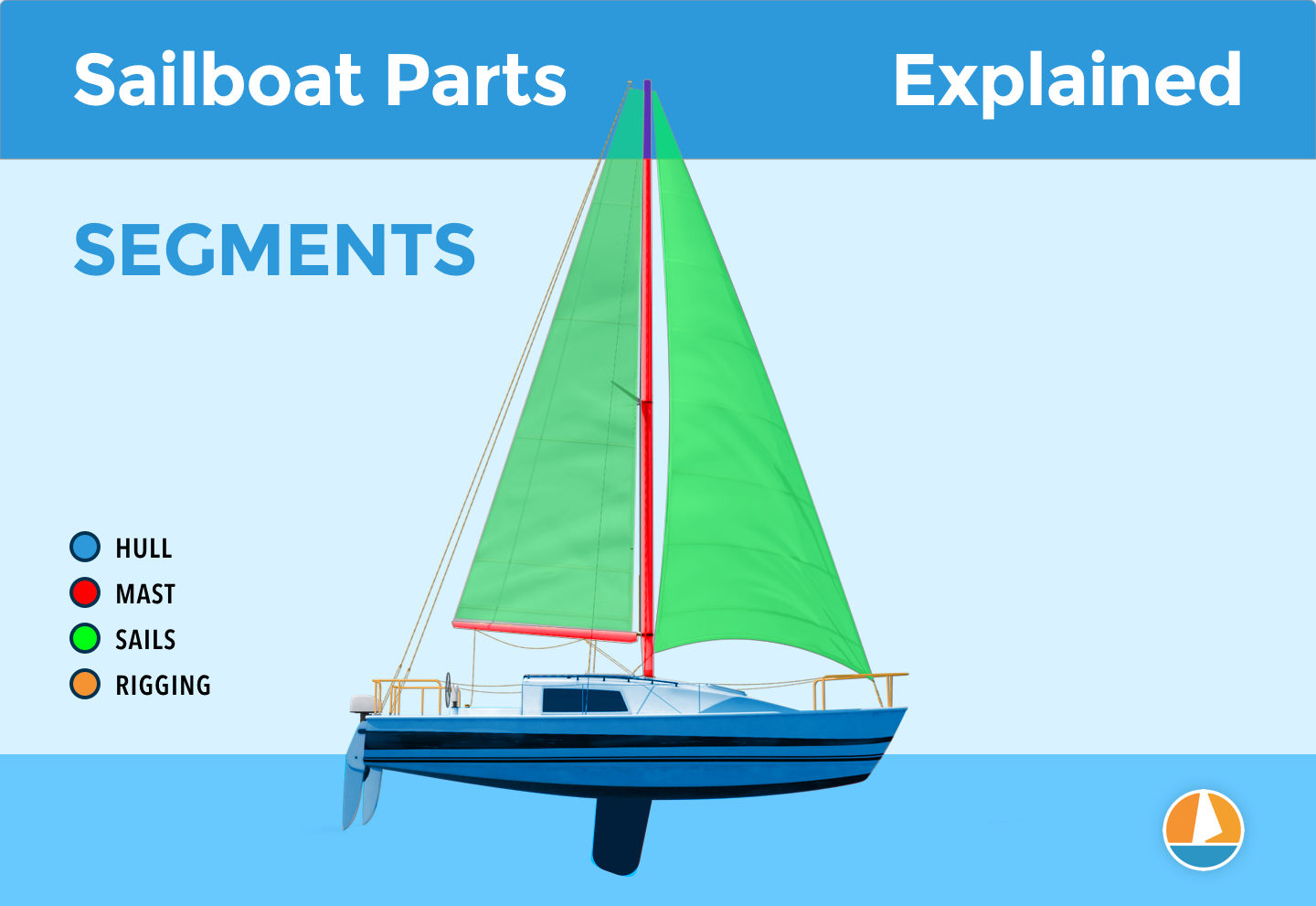
The hull is what most people would consider 'the boat'. It's the part that provides buoyancy and carries everything else: sails, masts, rigging, and so on. Without the hull, there would be no boat. The hull can be divided into different parts: deck, keel, cabin, waterline, bilge, bow, stern, rudder, and many more.
I'll show you those specific parts later on. First, let's move on to the mast.

Sailboats Explained
The mast is the long, standing pole holding the sails. It is typically placed just off-center of a sailboat (a little bit to the front) and gives the sailboat its characteristic shape. The mast is crucial for any sailboat: without a mast, any sailboat would become just a regular boat.
I think this segment speaks mostly for itself. Most modern sailboats you see will have two sails up, but they can carry a variety of other specialty sails. And there are all kinds of sail plans out there, which determine the amount and shape of sails that are used.
The Rigging
This is probably the most complex category of all of them.
Rigging is the means with which the sails are attached to the mast. The rigging consists of all kinds of lines, cables, spars, and hardware. It's the segment with the most different parts.
The most important parts
If you learn anything from this article, here are the most important parts of any sailboat. You will find all of these parts in some shape or form on almost any sailboat.
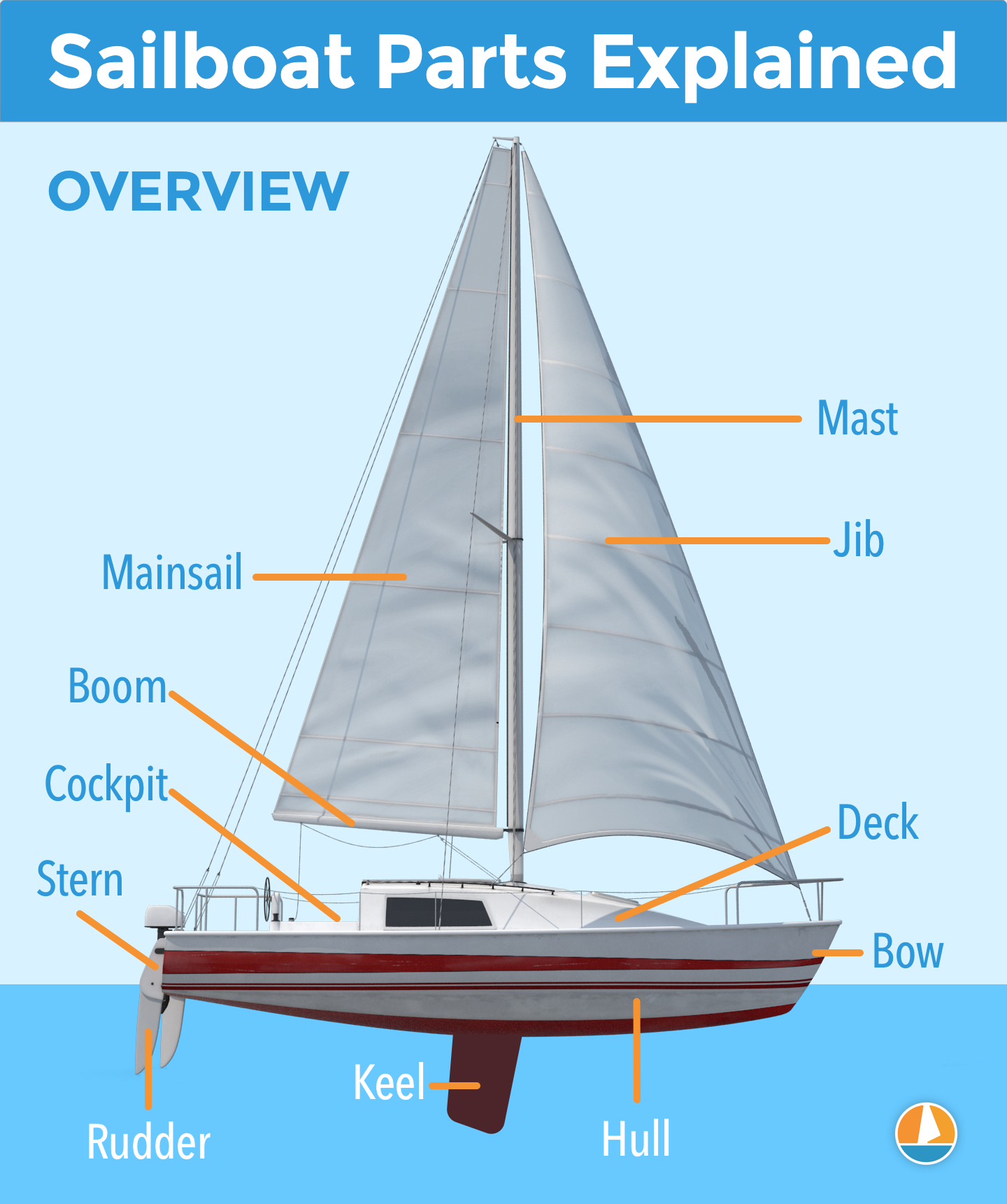
Okay, we now have a good starting point and a good basic understanding of the different sailboat parts. It's time for the good stuff. We're going to dive into each segment in detail.
Below, I'll go over them one by one, pointing out its different parts on a diagram, listing them with a brief explanation, and showing you examples as well.
After reading this article, you'll recognize every single sailboat part and know them by name. And if you forget one, you're free to look it up in this guide.
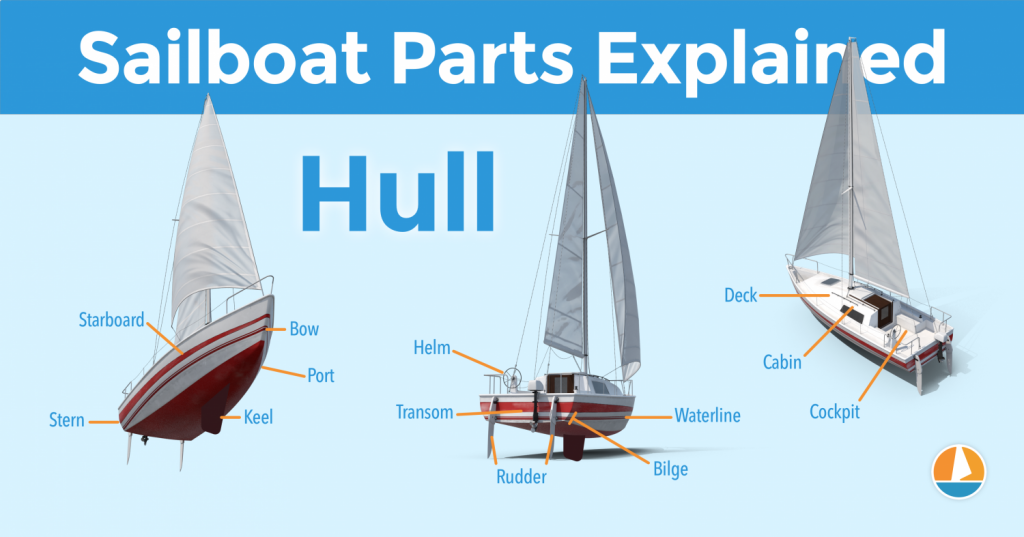
On this page:
The hull is the heart of the boat. It's what carries everything: the mast, the sails, the rigging, the passengers. The hull is what provides the sailboat with its buoyancy, allowing it to stay afloat.
Sailboats mostly use displacement hulls, which is a shape that displaces water when moving through it. They are generally very round and use buoyancy to support its own weight. These two characteristics make sure it is a smooth ride.
There are different hull shapes that work and handle differently. If you want to learn more about them, here's the Illustrated Guide to Boat Hull Types (with 11 Examples ). But for now, all we need to know is that the hull is the rounded, floating part of any sailboat.
Instead of simply calling the different sides of a hull front, back, left and right , we use different names in sailing. Let's take a look at them.
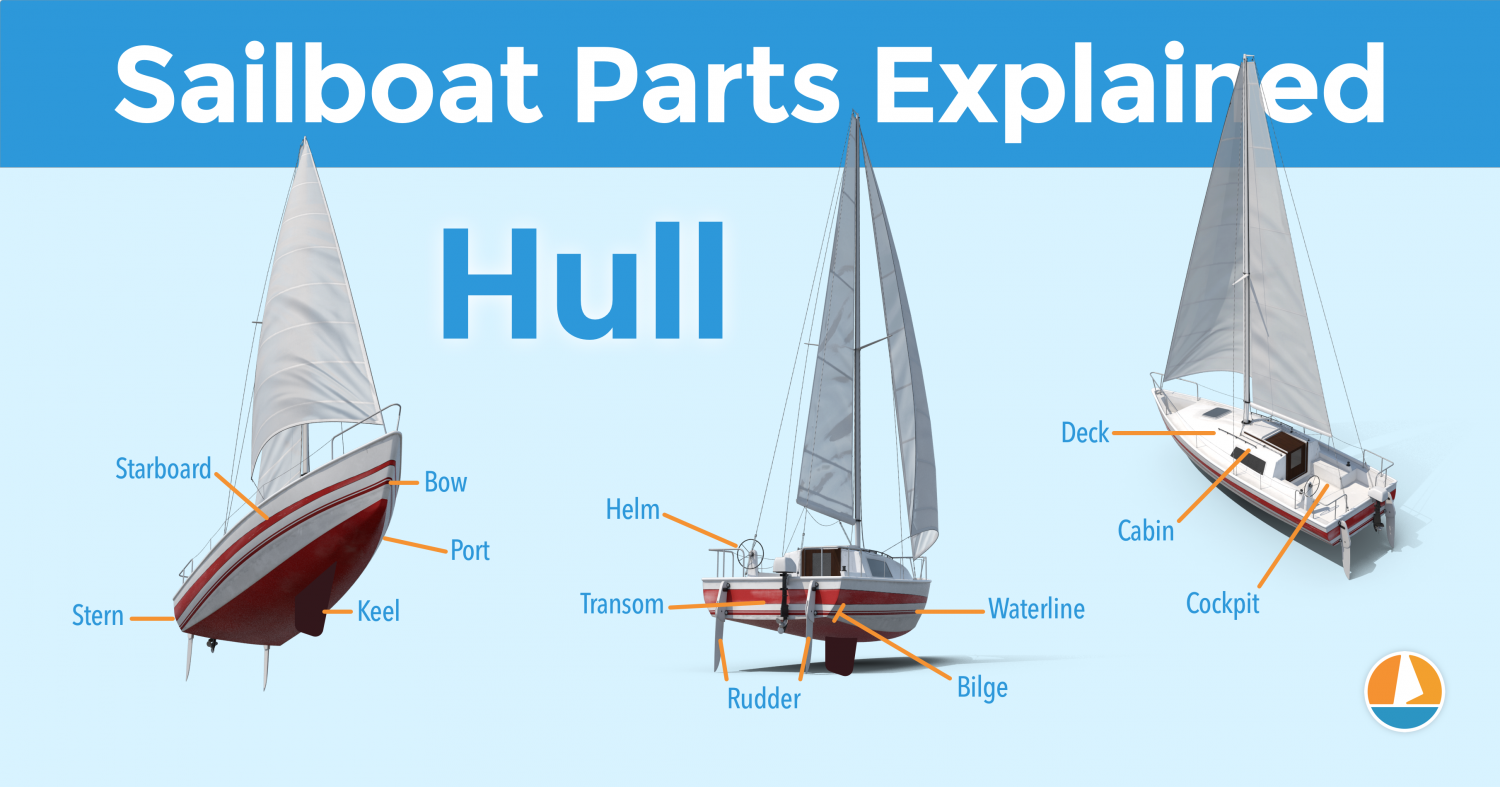
The bow is the front part of the hull. It's simply the nautical word for 'front'. It's the pointy bit that cuts through the water. The shape of the bow determines partially how the boat handles.
The stern is the back part of the hull. It's simply the nautical word for 'back'. The shape of the stern partially determines the stability and speed of the boat. With motorboats, the stern lies deep inside the water, and the hull is flatter aft. Aft also means back. This allows it to plane, increasing the hull speed. For sailboats, stability is much more important, so the hull is rounded throughout, increasing its buoyancy and hydrodynamic properties.
The transom is the backplate of the boat's hull. It's the most aft (rear) part of the boat.
Port is the left side of a sailboat.
Starboard is the right side of a sailboat
The bilges are the part where the bottom and the sides of the hull meet. On sailboats, these are typically very round, which helps with hydrodynamics. On powerboats, they tend to have an angle.
The waterline is the point where the boat's hull meets the water. Generally, boat owners paint the waterline and use antifouling paint below it, to protect it from marine growth.
The deck is the top part of the boat's hull. In a way, it's the cap of the boat, and it holds the deck hardware and rigging.
Displacement hulls are very round and smooth, which makes them very efficient and comfortable. But it also makes them very easy to capsize: think of a canoe, for example.
The keel is a large fin that offsets the tendency to capsize by providing counterbalance. Typically, the keel carries ballast in the tip, creating a counterweight to the wind's force on the sails.
The rudder is the horizontal plate at the back of the boat that is used to steer by setting a course and maintaining it. It is connected to the helm or tiller.
Tiller or Helm
- The helm is simply the nautical term for the wheel.
- The tiller is simply the nautical term for the steering stick.
The tiller or helm is attached to the rudder and is used to steer the boat. Most smaller sailboats (below 30') have a tiller, most larger sailboats use a helm. Large ocean-going vessels tend to have two helms.
The cockpit is the recessed part in the deck where the helmsman sits or stands. It tends to have some benches. It houses the outside navigation and systems interfaces, like the compass, chartplotter, and so on. It also houses the mainsheet traveler and winches for the jib. Most boats are set up so that the entire vessel can be operated from the cockpit (hence the name). More on those different parts later.
Most larger boats have some sort of roofed part, which is called the cabin. The cabin is used as a shelter, and on cruising sailboats you'll find the galley for cooking, a bed, bath room, and so on.
The mast is the pole on a sailboat that holds the sails. Sailboats can have one or multiple masts, depending on the mast configuration. Most sailboats have only one or two masts. Three masts or more is less common.
The boom is the horizontal pole on the mast, that holds the mainsail in place.
The sails seem simple, but actually consist of many moving parts. The parts I list below work for most modern sailboats - I mean 90% of them. However, there are all sorts of specialty sails that are not included here, to keep things concise.

The mainsail is the largest sail on the largest mast. Most sailboats use a sloop rigging (just one mast with one bermuda mainsail). In that case, the main is easy to recognize. With other rig types, it gets more difficult, since there can be multiple tall masts and large sails.
If you want to take a look at the different sail plans and rig types that are out there, I suggest reading my previous guide on how to recognize any sailboat here (opens in new tab).
Sail sides:
- Leech - Leech is the name for the back side of the sail, running from the top to the bottom.
- Luff - Luff is the name for the front side of the sail, running from the top to the bottom.
- Foot - Foot is the name for the lower side of the sail, where it meets the boom.
Sail corners:
- Clew - The clew is the lower aft (back) corner of the mainsail, where the leech is connected to the foot. The clew is attached to the boom.
- Tack - The tack is the lower front corner of the mainsail
- Head - The head is the top corner of the mainsail
Battens are horizontal sail reinforcers that flatten and stiffen the sail.
Telltales are small strings that show you whether your sail trim is correct. You'll find telltales on both your jib and mainsail.
The jib is the standard sized headsail on a Bermuda Sloop rig (which is the sail plan most modern sailboats use).
As I mentioned: there are all kinds, types, and shapes of sails. For an overview of the most common sail types, check out my Guide on Sail Types here (with photos).
The rigging is what is used to attach your sails and mast to your boat. Rigging, in other words, mostly consists of all kinds of lines. Lines are just another word for ropes. Come to think of it, sailors really find all kinds of ways to complicate the word rope ...
Two types of rigging
There are two types of rigging: running and standing rigging. The difference between the two is very simple.
- The running rigging is the rigging on a sailboat that's used to operate the sails. For example, the halyard, which is used to lower and heave the mainsail.
- The standing rigging is the rigging that is used to support the mast and sail plan.
Standing Rigging
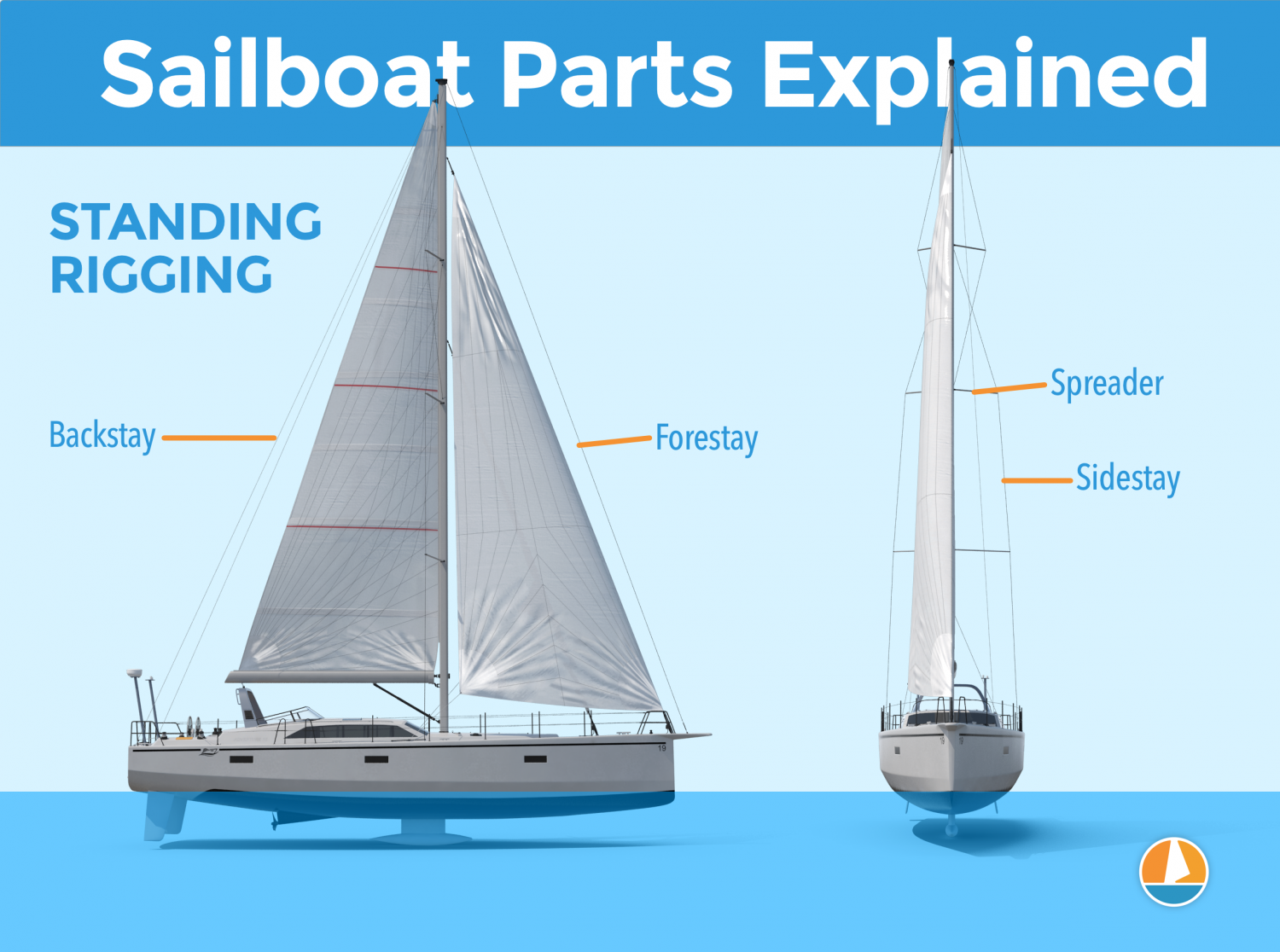
Here are the different parts that belong to the standing rigging:
- Forestay or Headstay - Line or cable that supports the mast and is attached to the bow of the boat. This is often a steel cable.
- Backstay - Line or cable that supports the mast and is attached to the stern of the boat. This is often a steel cable.
- Sidestay or Shroud - Line or cable that supports the mast from the sides of the boat. Most sailboats use at least two sidestays (one on each side).
- Spreader - The sidestays are spaced to steer clear from the mast using spreaders.
Running Rigging: different words for rope
Ropes play a big part in sailing, and especially in control over the sails. In sailboat jargon, we call ropes 'lines'. But there are some lines with a specific function that have a different name. I think this makes it easier to communicate with your crew: you don't have to define which line you mean. Instead, you simply shout 'mainsheet!'. Yeah, that works.
Running rigging consists of the lines, sheets, and hardware that are used to control, raise, lower, shape and manipulate the sails on a sailboat. Rigging varies for different rig types, but since most sailboats are use a sloop rig, nearly all sailboats use the following running rigging:
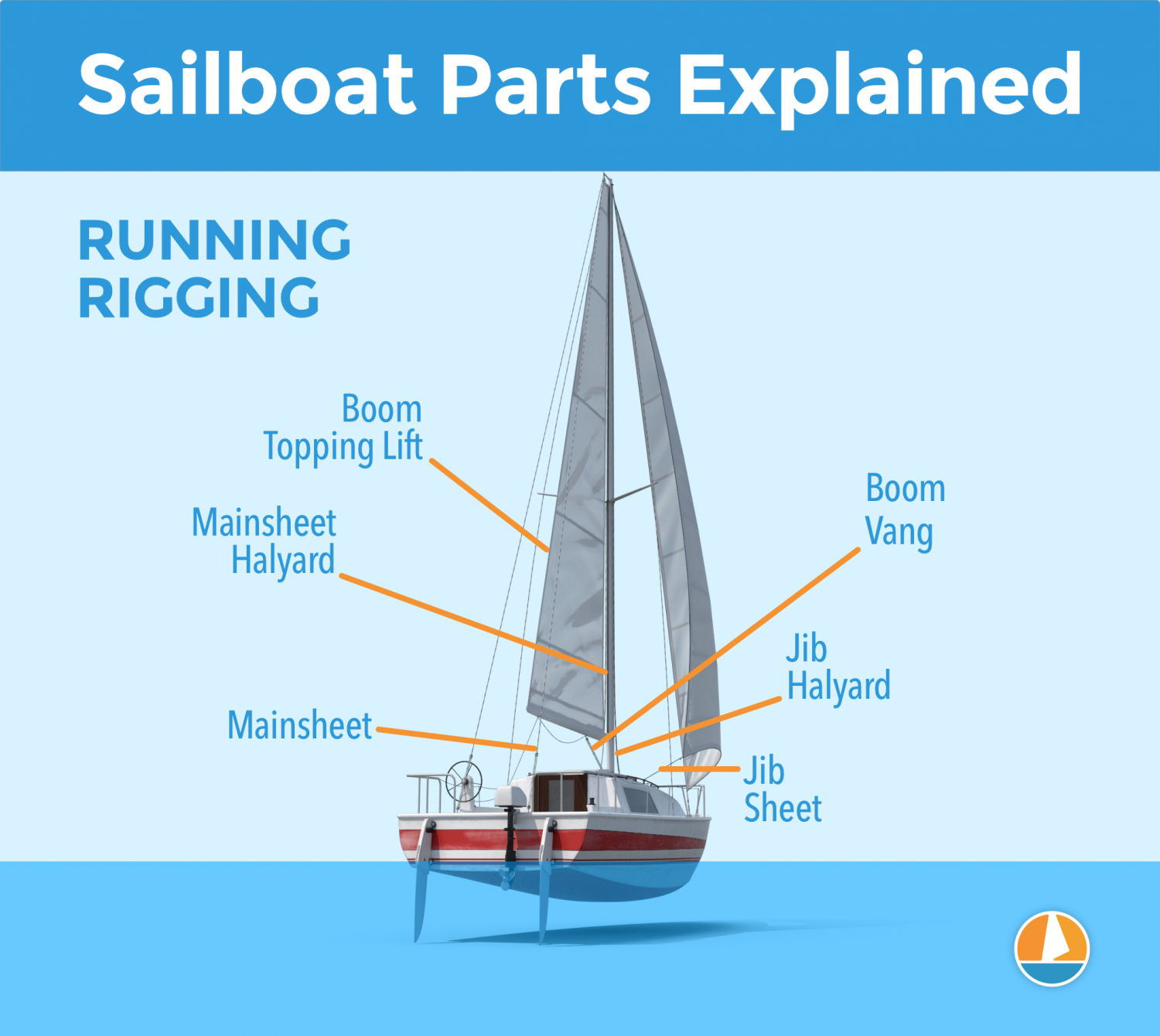
- Halyards -'Halyard' is simply the nautical name for lines or ropes that are used to raise and lower the mainsail. The halyard is attached to the top of the mainsail sheet, or the gaffer, which is a top spar that attaches to the mainsail. You'll find halyards on both the mainsail and jib.
- Sheets - 'Sheet' is simply the nautical term for lines or ropes that are used to set the angle of the sail.
- Mainsheet - The line, or sheet, that is used to set the angle of the mainsail. The mainsheet is attached to the Mainsheet traveler. More on that under hardware.
- Jib Sheet - The jib mostly comes with two sheets: one on each side of the mast. This prevents you from having to loosen your sheet, throwing it around the other side of the mast, and tightening it. The jib sheets are often controlled using winches (more on that under hardware).
- Cleats are small on-deck hooks that can be used to tie down sheets and lines after trimming them.
- Reefing lines - Lines that run through the mainsail, used to put a reef in the main.
- The Boom Topping Lift is a line that is attached to the aft (back) end of the boom and runs to the top of the mast. It supports the boom whenever you take down the mainsail.
- The Boom Vang is a line that places downward tension on the boom.
There are some more tensioning lines, but I'll leave them for now. I could probably do an entire guide on the different sheets on a sailboat. Who knows, perhaps I'll write it.
This is a new segment, that I didn't mention before. It's a bit of an odd duck, so I threw all sorts of stuff into this category. But they are just as important as all the other parts. Your hardware consists of cleats, winches, traveler and so on. If you don't know what all of this means, no worries: neither did I. Below, you'll find a complete overview of the different parts.
Deck Hardware
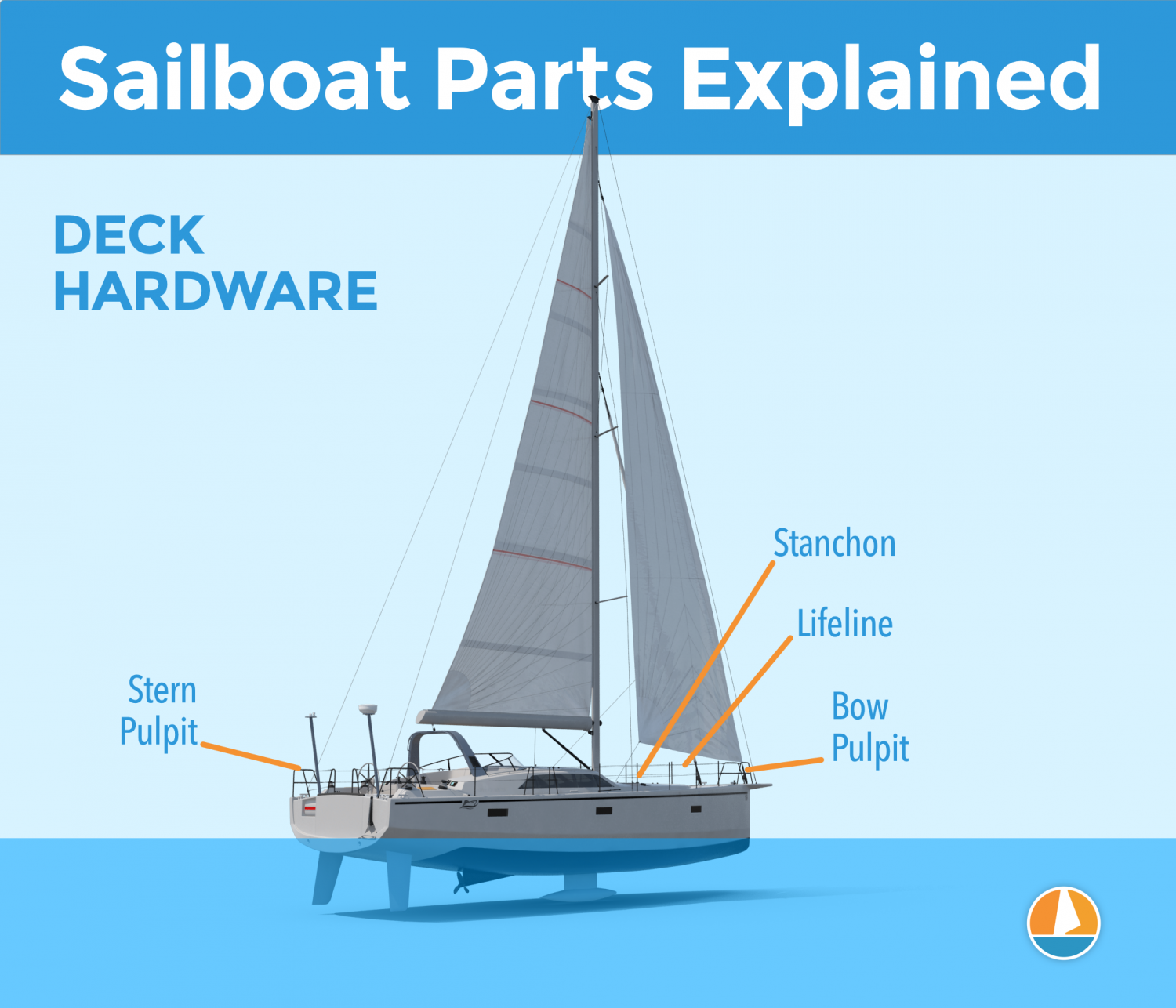
Just a brief mention of the different deck hardware parts:
- Pulpits are fenced platforms on the sailboat's stern and bow, which is why they are called the bow pulpit and stern pulpit here. They typically have a solid steel framing for safety.
- Stanchons are the standing poles supporting the lifeline , which combined for a sort of fencing around the sailboat's deck. On most sailboats, steel and steel cables are used for the stanchons and lifelines.
Mainsheet Traveler
The mainsheet traveler is a rail in the cockpit that is used to control the mainsheet. It helps to lock the mainsheet in place, fixing the mainsails angle to the wind.
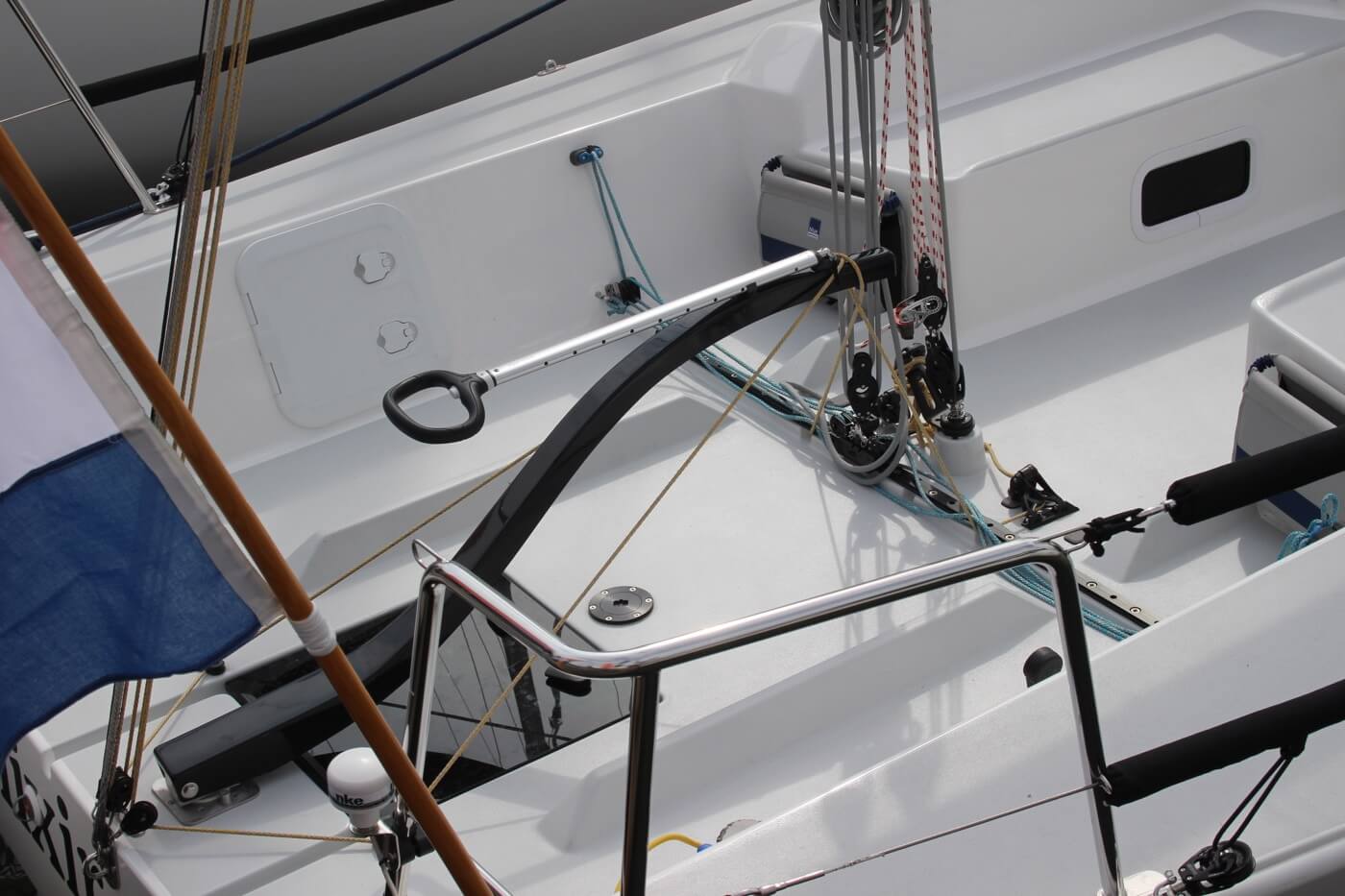
If you're interested in learning more about how to use the mainsheet traveler, Matej has written a great list of tips for using your mainsheet traveler the right way . It's a good starting point for beginners.
Winches are mechanical or electronic spools that are used to easily trim lines and sheets. Most sailboats use winches to control the jib sheets. Modern large sailing yachts use electronic winches for nearly all lines. This makes it incredibly easy to trim your lines.
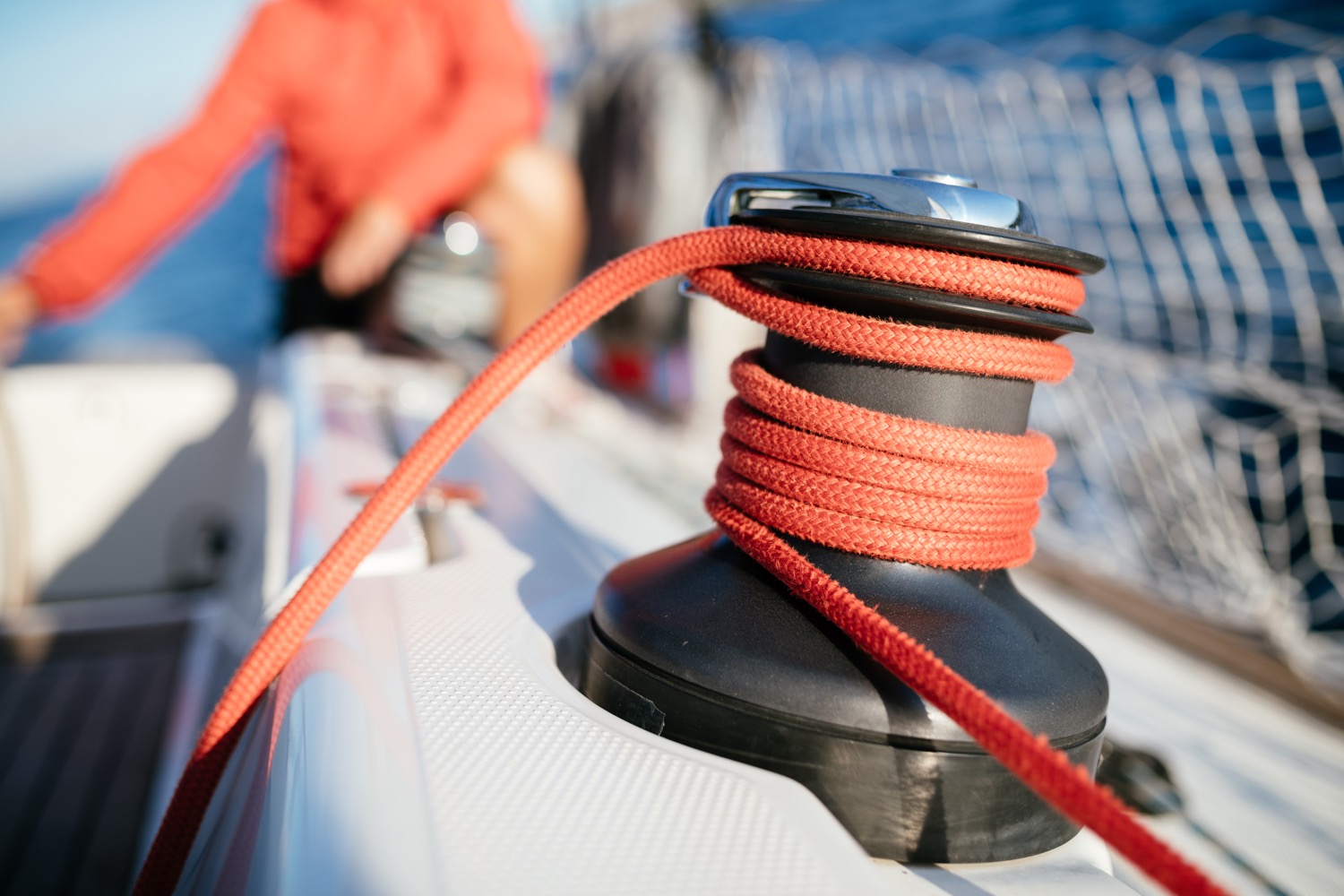
You'll find the compass typically in the cockpit. It's the most old-skool navigation tool out there, but I'm convinced it's also one of the most reliable. In any way, it definitely is the most solid backup navigator you can get for the money.
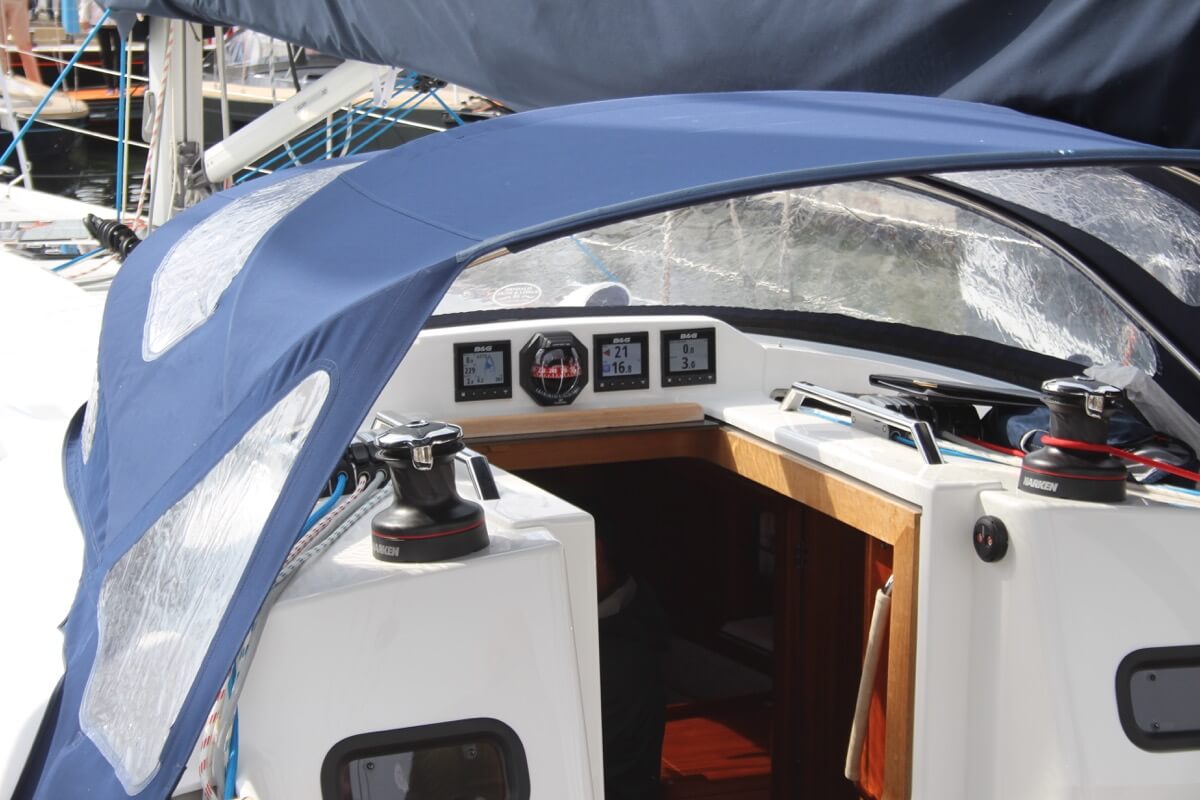
Want to learn how to use a compass quickly and reliably? It's easy. Just read my step-by-step beginner guide on How To Use a Compass (opens in new tab .
Chartplotter
Most sailboats nowadays use, besides a compass and a map, a chartplotter. Chartplotters are GPS devices that show a map and a course. It's very similar to your normal car navigation.
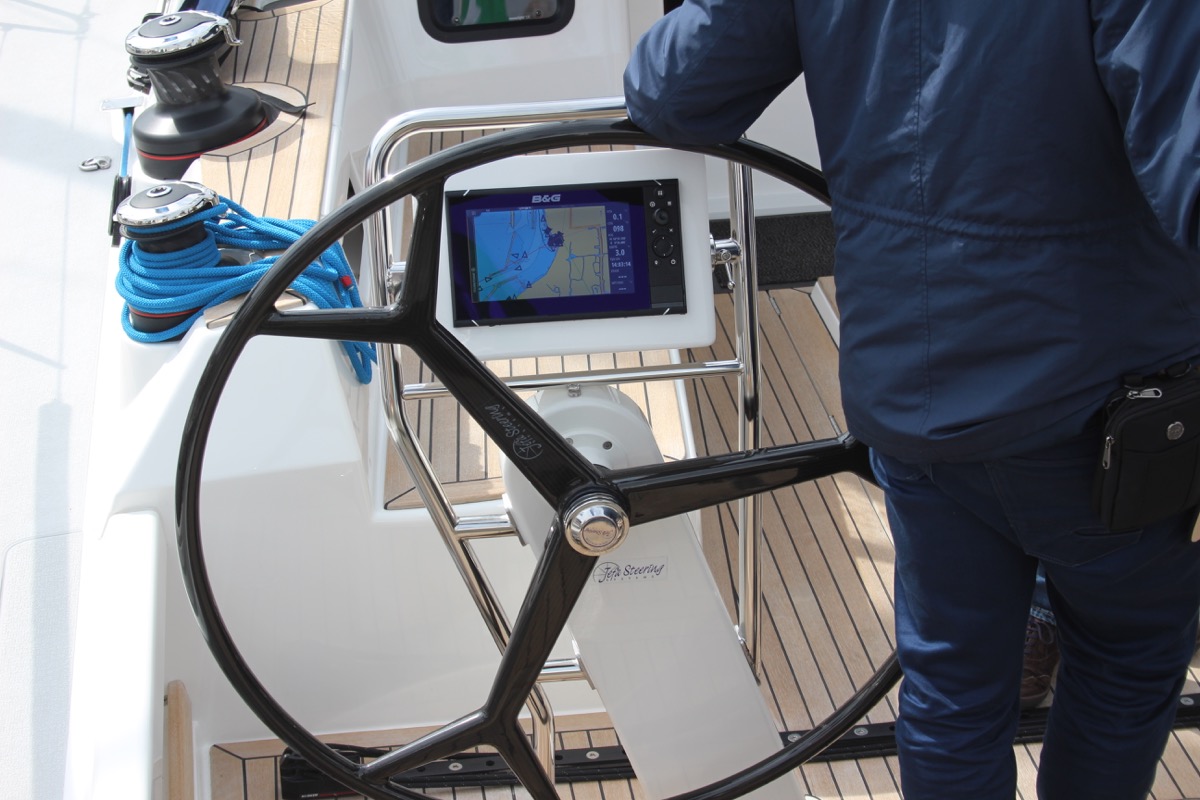
Outboard motor
Most sailboats have some sort of motor to help out when there's just the slightest breeze. These engines aren't very big or powerful, and most sailboats up to 32' use an outboard motor. You'll find these at the back of the boat.

Most sailboats carry 1 - 3 anchors: one bow anchor (the main one) and two stern anchors. The last two are optional and are mostly used by bluewater cruisers.
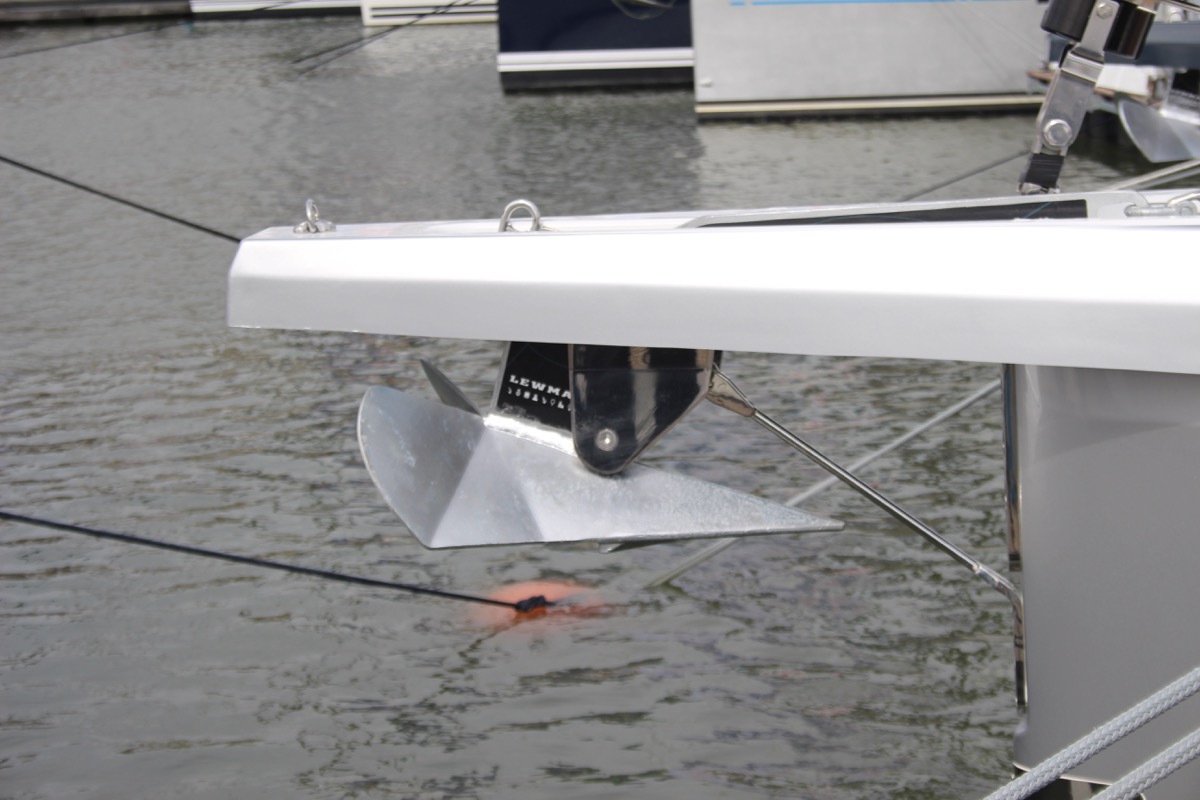
I hope this was helpful, and that you've gained a good understanding of the different parts involved in sailing. I wanted to write a good walk-through instead of overwhelming you with lists and lists of nautical terms. I hope I've succeeded. If so, I appreciate any comments and tips below.
I've tried to be as comprehensive as possible, without getting into the real nitty gritty. That would make for a gigantic article. However, if you feel I've left something out that really should be in here, please let me know in the comments below, so I can update the article.
I own a small 20 foot yacht called a Red witch made locally back in the 70s here in Western Australia i found your article great and enjoyed reading it i know it will be a great help for me in my future leaning to sail regards John.
David Gardner
İ think this is a good explanation of the difference between a ”rope” and a ”line”:
Rope is unemployed cordage. In other words, when it is in a coil and has not been assigned a job, it is just a rope.
On the other hand, when you prepare a rope for a specific task, it becomes employed and is a line. The line is labeled by the job it performs; for example, anchor line, dock line, fender line, etc.
Hey Mr. Buckles
I am taking on new crew to race with me on my Flying Scot (19ft dingy). I find your Sailboat Parts Explained to be clear and concise. I believe it will help my new crew learn the language that we use on the boat quickly without being overwhelmed.
PS: my grandparents were from Friesland and emigrated to America.
Thank you Shawn for the well written, clear and easy to digest introductory article. Just after reading this first article I feel excited and ready to set sails and go!! LOL!! Cheers! Daniel.
steve Balog
well done, chap
Great intro. However, the overview diagram misidentifies the cockpit location. The cockpit is located aft of the helm. Your diagram points to a location to the fore of the helm.
William Thompson-Ambrose
An excellent introduction to the basic anatomy and function of the sailboat. Anyone who wants to start sailing should consider the above article before stepping aboard! Thank-you
James Huskisson
Thanks for you efforts mate. We’ve all got to start somewhere. Thanks for sharing. Hoping to my first yacht. 25ft Holland. Would love to cross the Bass Strait one day to Tasmania. 👌 Cheers mate
Alan Alexander Percy
thankyou ijust aquired my first sailboat at 66yrs of age its down at pelican point a beautifull place in virginia usa my sailboat is a redwing 30 if you are ever in the area i wouldnt mind your guidance and superior knowledge of how to sail but iam sure your fantastic article will help my sailboat is wings 30 ft
Thanks for quick refresher course. Having sailed in California for 20+ years I now live in Spain where I have to take a spanish exam for a sailboat license. Problem is, it’s only in spanish. So a lot to learn for an old guy like me.
Very comprehensive, thank you
Your article really brought all the pieces together for me today. I have been adventuring my first sailing voyage for 2 months from the Carolinas and am now in Eleuthera waiting on weather to make the Exumas!!! Great job and thanks
Helen Ballard
I’ve at last found something of an adventure to have in sailing, so I’m starting at the basics, I have done a little sailing but need more despite being over 60 life in the old dog etc, thanks for your information 😊
Barbara Scott
I don’t have a sailboat, neither do l plan to literally take to the waters. But for mental exercise, l have decided to take to sailing in my Bermuda sloop, learning what it takes to become a good sailor and run a tight ship, even if it’s just imaginary. Thank you for helping me on my journey to countless adventures and misadventures, just to keep it out of the doldrums! (I’m a 69 year old African American female who have rediscovered why l enjoyed reading The Adventures of Robert Louis Stevenson as well as his captivating description of sea, wind, sailboat,and sailor).
Great article and very good information source for a beginner like me. But I didn’t find out what I had hoped to, which is, what are all those noisy bits of kit on top of the mast? I know the one with the arrow is a weather vane, but the rest? Many thanks, Jay.
Louis Cohen
The main halyard is attached to the head of the mainsail, not the to the mainsheet. In the USA, we say gaff, not gaffer. The gaff often has its own halyard separate from the main halyard.
Other than that it’s a nice article with good diagrams.
A Girl Who Has an Open Sail Dream
Wow! That was a lot of great detail! Thank you, this is going to help me a lot on my project!
Hi, good info, do u know a book that explains all the systems on a candc 27,
Leave a comment
You may also like, guide to understanding sail rig types (with pictures).
There are a lot of different sail rig types and it can be difficult to remember what's what. So I've come up with a system. Let me explain it in this article.
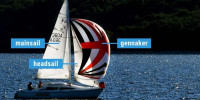
The Ultimate Guide to Sail Types and Rigs (with Pictures)
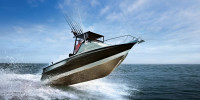
The Illustrated Guide To Boat Hull Types (11 Examples)


How To Live On a Boat For Free: How I'd Do It

How To Live on a Sailboat: Consider These 5 Things
Standing Rigging (or ‘Name That Stay’)
Published by rigworks on november 19, 2019.
Question: When your riggers talk about standing rigging, they often use terms I don’t recognize. Can you break it down for me?
From the Rigger: Let’s play ‘Name that Stay’…
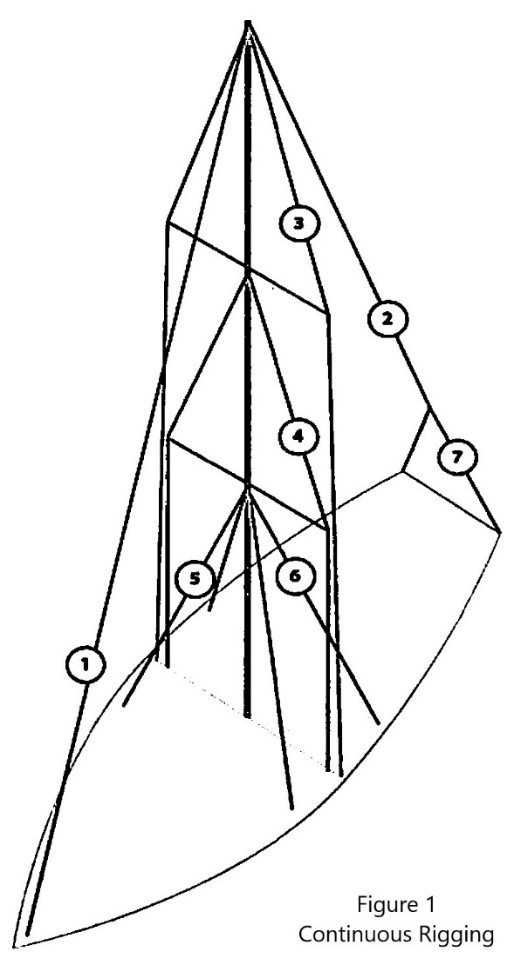
Forestay (1 or HS) – The forestay, or headstay, connects the mast to the front (bow) of the boat and keeps your mast from falling aft.
- Your forestay can be full length (masthead to deck) or fractional (1/8 to 1/4 from the top of the mast to the deck).
- Inner forestays, including staysail stays, solent stays and baby stays, connect to the mast below the main forestay and to the deck aft of the main forestay. Inner forestays allow you to hoist small inner headsails and/or provide additional stability to your rig.
Backstay (2 or BS) – The backstay runs from the mast to the back of the boat (transom) and is often adjustable to control forestay tension and the shape of the sails.
- A backstay can be either continuous (direct from mast to transom) or it may split in the lower section (7) with “legs” that ‘V’ out to the edges of the transom.
- Backstays often have hydraulic or manual tensioners built into them to increase forestay tension and bend the mast, which flattens your mainsail.
- Running backstays can be removable, adjustable, and provide additional support and tuning usually on fractional rigs. They run to the outer edges of the transom and are adjusted with each tack. The windward running back is in tension and the leeward is eased so as not to interfere with the boom and sails.
- Checkstays, useful on fractional rigs with bendy masts, are attached well below the backstay and provide aft tension to the mid panels of the mast to reduce mast bend and provide stabilization to reduce the mast from pumping.
Shrouds – Shrouds support the mast from side to side. Shrouds are either continuous or discontinuous .
Continuous rigging, common in production sailboats, means that each shroud (except the lowers) is a continuous piece of material that connects to the mast at some point, passes through the spreaders without terminating, and continues to the deck. There may be a number of continuous shrouds on your boat ( see Figure 1 ).
- Cap shrouds (3) , sometimes called uppers, extend from masthead to the chainplates at the deck.
- Intermediate shrouds (4) extend from mid-mast panel to deck.
- Lower shrouds extend from below the spreader-base to the chainplates. Fore- (5) and Aft-Lowers (6) connect to the deck either forward or aft of the cap shroud.
Discontinuous rigging, common on high performance sailboats, is a series of shorter lengths that terminate in tip cups at each spreader. The diameter of the wire/rod can be reduced in the upper sections where loads are lighter, reducing overall weight. These independent sections are referred to as V# and D# ( see Figure 2 ). For example, V1 is the lowest vertical shroud that extends from the deck to the outer tip of the first spreader. D1 is the lowest diagonal shroud that extends from the deck to the mast at the base of the first spreader. The highest section that extends from the upper spreader to the mast head may be labeled either V# or D#.
A sailboat’s standing rigging is generally built from wire rope, rod, or occasionally a super-strong synthetic fibered rope such as Dyneema ® , carbon fiber, kevlar or PBO.
- 1×19 316 grade stainless steel Wire Rope (1 group of 19 wires, very stiff with low stretch) is standard on most sailboats. Wire rope is sized/priced by its diameter which varies from boat to boat, 3/16” through 1/2″ being the most common range.
- 1×19 Compact Strand or Dyform wire, a more expensive alternative, is used to increase strength, reduce stretch, and minimize diameter on high performance boats such as catamarans. It is also the best alternative when replacing rod with wire.
- Rod rigging offers lower stretch, longer life expectancy, and higher breaking strength than wire. Unlike wire rope, rod is defined by its breaking strength, usually ranging from -10 to -40 (approx. 10k to 40k breaking strength), rather than diameter. So, for example, we refer to 7/16” wire (diameter) vs. -10 Rod (breaking strength).
- Composite Rigging is a popular option for racing boats. It offers comparable breaking strengths to wire and rod with a significant reduction in weight and often lower stretch.
Are your eyes crossing yet? This is probably enough for now, but stay tuned for our next ‘Ask the Rigger’. We will continue this discussion with some of the fittings/connections/hardware associated with your standing rigging.
Related Posts
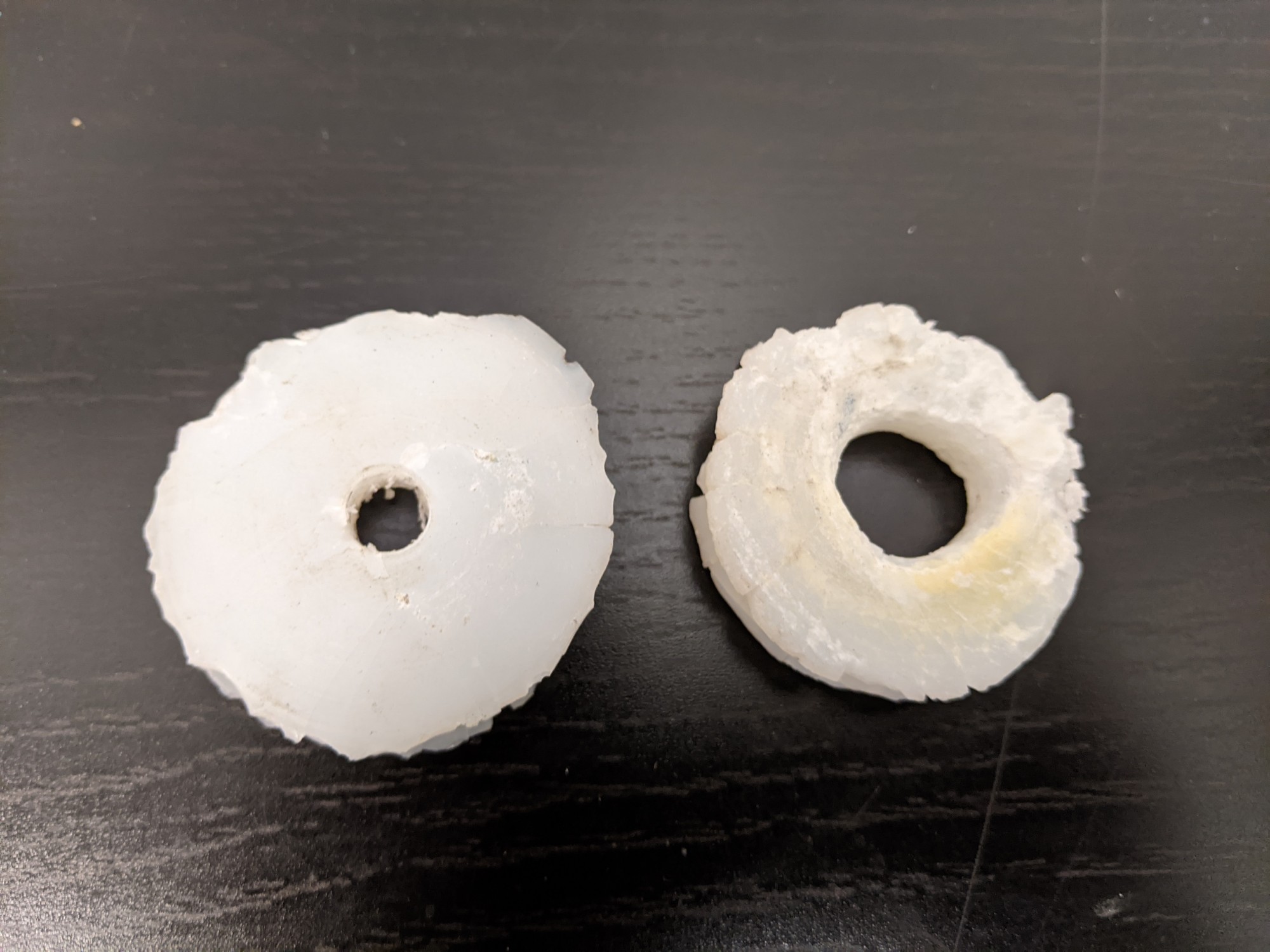
Do Your Masthead Sheaves Need Replacing?
Question: My halyard is binding. What’s up? From the Rigger: Most boat owners do not climb their masts regularly, but our riggers spend a lot of time up there. And they often find badly damaged Read more…
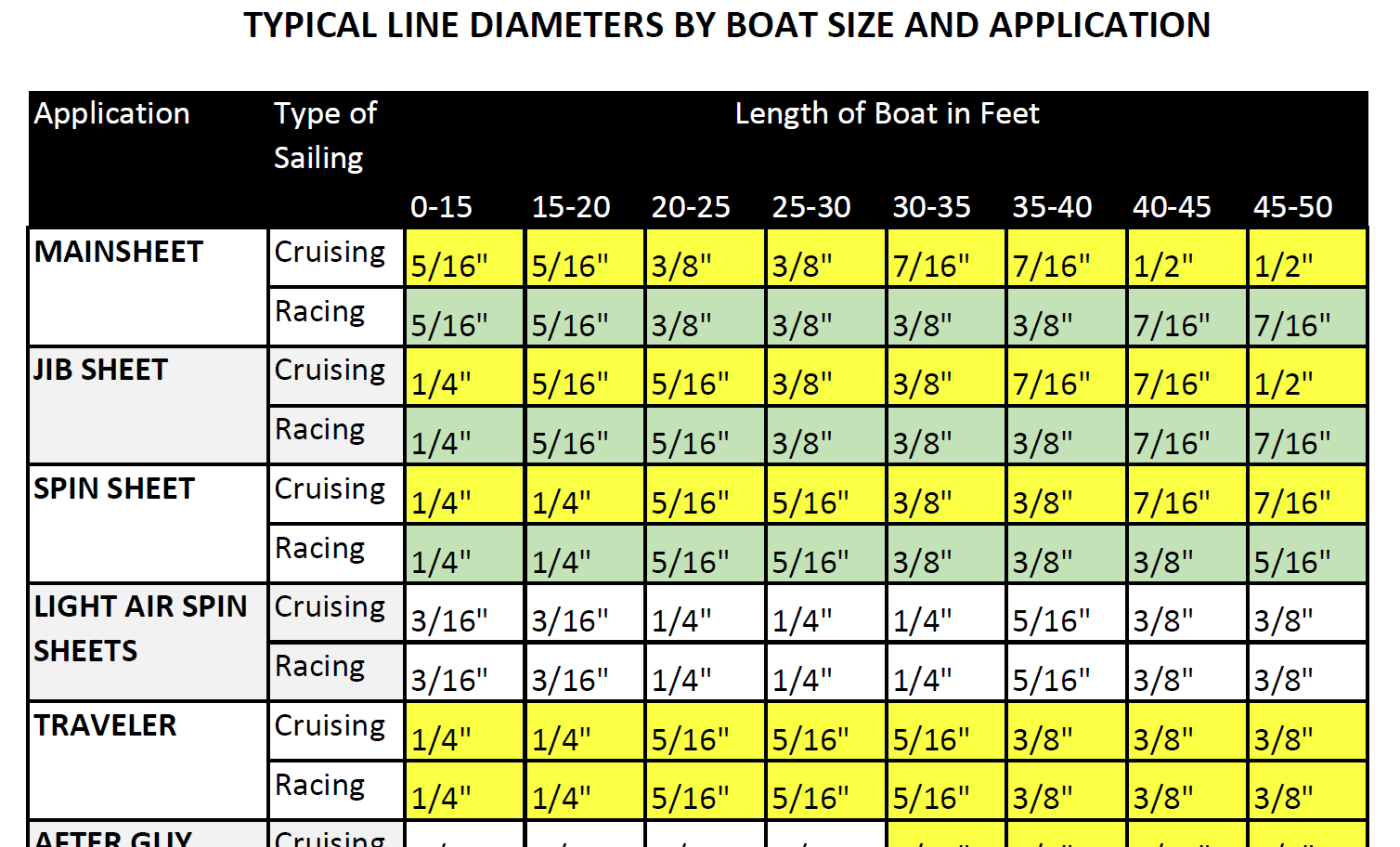
Selecting Rope – Length, Diameter, Type
Question: Do you have guidelines for selecting halyards, sheets, etc. for my sailboat? From the Rigger: First, if your old rope served its purpose but needs replacing, we recommend duplicating it as closely as possible Read more…

Spinlock Deckvest Maintenance
Question: What can I do to ensure that my Spinlock Deckvest is well-maintained and ready for the upcoming season? From the Rigger: We are so glad you asked! Deckvests need to be maintained so that Read more…
- Boating Safety
- Company News
Experiences
- Destinations
- Boating Regulations
- Sailboat Rigging Basics: A Guide to Understanding and Maintaining Your Rig
Sailing is a thrilling experience, offering a unique blend of adventure, relaxation, and connection with nature. Central to this experience is the sailboat's rigging system, a complex network of ropes, wires, and chains that control the sails and mast. Understanding and maintaining your rig is crucial for safe and enjoyable sailing. Let's dive into the basics of sailboat rigging.
Understanding Your Sailboat's Rigging
Types of rigging.
There are several types of sailboat rigging, each with its unique characteristics and uses. Here are the most common ones:
- Sloop Rigging: This is the most common type of rigging, featuring a single mast and two sails.
- Cutter Rigging: Similar to sloop rigging but with an additional headsail for better performance in high winds.
- Ketch Rigging: This type features two masts, with the mizzen mast located forward of the rudder post.
- Yawl Rigging: Like the ketch, a yawl has two masts, but the mizzen mast is aft of the rudder post.
- Schooner Rigging: A schooner has two or more masts, with the forward mast shorter or equal to the aft mast(s).
Components of Rigging
Regardless of the type, all sailboat rigging systems consist of several key components. Understanding these components is the first step to mastering your rig:
- Mast: The tall vertical pole that supports the sails.
- Boom: The horizontal pole attached to the mast, which extends the foot of the sail.
- Standing Rigging: The fixed rigging that supports the mast, including the forestay, backstay, and shrouds.
- Running Rigging: The movable rigging used to control the sails, including the halyards, sheets, and outhauls.
- Blocks: Pulleys used to redirect the force applied to the running rigging.
- Winches: Devices used to tighten or loosen the running rigging.
Maintaining Your Sailboat's Rigging
Regular inspection.
Regular inspection is the cornerstone of rigging maintenance. It helps identify potential issues before they become serious problems. Here are some key areas to focus on:
- Mast and Boom: Check for cracks, corrosion, and loose fittings.
- Standing Rigging: Inspect for signs of wear, such as fraying wires, bent fittings, and rust.
- Running Rigging: Look for frayed ropes, worn blocks, and sticky winches.
- Sails: Check for tears, loose stitching, and worn corners.
Regular Cleaning
Cleaning your rigging regularly can prevent corrosion and prolong its lifespan. Here's a simple cleaning routine:
- Rinse with Fresh Water: After each sail, rinse your rigging with fresh water to remove salt and grime.
- Clean with Mild Soap: Every few months, clean your rigging with a mild soap and a soft brush.
- Lubricate Moving Parts: Apply a marine-grade lubricant to all moving parts, such as blocks and winches.
Professional Servicing
While regular inspection and cleaning can keep your rigging in good shape, it's also important to have it professionally serviced. A professional rigger can spot issues that you might miss and perform necessary repairs or replacements. Aim for a professional service at least once a year.
Learning to Sail: Practice Makes Perfect
Hands-on experience.
Understanding your rigging is one thing, but mastering it requires hands-on experience. Here are some ways to gain practical experience:
- Sailing Courses: Enroll in a sailing course to learn the basics under the guidance of experienced instructors.
- Practice Sailing: Spend as much time as possible on the water, practicing different sailing maneuvers and techniques.
- Join a Sailing Club: Joining a sailing club can provide opportunities to sail regularly and learn from other sailors.
Charter a Sailboat
If you don't own a sailboat, chartering one can be a great way to practice your skills. Getmyboat offers a wide range of sailboats for charter, from small dinghies to large yachts. Always check Getmyboat first when looking to book a sailboat charter.
Understanding and maintaining your sailboat's rigging is essential for safe and enjoyable sailing. By familiarizing yourself with the different types and components of rigging, regularly inspecting and cleaning your rigging, and gaining hands-on experience, you can become a confident and competent sailor. So get out there, hoist those sails, and enjoy the ride!
Set Sail with Confidence
Now that you're equipped with the knowledge to understand and maintain your sailboat's rigging, why not put your skills to the test on the open water? With Getmyboat , you can easily find and book the perfect boat for your next sailing adventure. Whether you prefer a captained experience or want to take the helm yourself, Getmyboat offers a fleet of over 150,000 boats, including sailboats, to choose from. Make it a boat day and create unforgettable memories on the water. Book your next sailing experience with Getmyboat today!
- How to Sail & Sailboats
Browse Trip Categories
- About Getmyboat
- Media Inquiries
- Terms of Use
- Privacy Policy
- Cookies Policy
- Accessibility Statement
- Member Interface Agreement
- How It Works
- Mobile Apps
- Boat Rentals
- Jet Ski Rental
- Fishing Charters
- Houseboat Rental
- Pontoon Rental
- Yacht Rental
- Sailboat Rental
- Bachelorette Party Boat Rental
- Party Boat Rentals
- Experiences Guide
Popular Destinations
- Lake Travis
- Lake Lanier
- Newport Beach
- Lake Norman
24/7 live support
- Help & FAQs
- +1 818 927 2148
- [email protected]
Real reviews from happy Getmyboaters.

What is Sailboat Rigging? (Understand the Basics)

If youve ever seen a sailboat gracefully cutting through the waves, you may have been in awe of the skill and knowledge of the sailors that make it possible.
But have you ever stopped to wonder whats making the sailboat move so efficiently? The answer is sailboat rigging.
In this article, well explain what sailboat rigging is, the components of it, the benefits it provides, how to adjust and maintain it, and provide some tips to help you get your sailboat moving smoothly.
So, if youre ready to learn the basics of sailboat rigging, lets get started!
Table of Contents
Short Answer
Sailboat rigging is the system of ropes, wires and other components that help a sailboat to operate.
It includes the sails, masts, booms, stays and lines that are used to support and control the sails and the boat itself.
The rigging is an important part of sailing, as it is responsible for the efficient use of the wind to move the boat forward.
Definition of Sailboat Rigging
Sailboat rigging is the collective system of ropes, wires, pulleys, and other equipment used to control the sails and other parts of a sailboat.
It is an essential component of sailing, and proper rigging can make a huge difference in the performance of a boat.
Rigging is used to adjust the shape and orientation of the sails to the wind, which helps the boat move along faster and more efficiently.
The rigging is made up of several components, including halyards, sheets, blocks, and cleats.
Halyards are the lines used to hoist and adjust the sails.
Sheets are the lines used to control the angle of the sails.
Blocks are the pulleys used to direct the lines and increase their mechanical advantage.
Cleats are the devices used to secure the lines and keep them in place.
Sailboat rigging is a complex and multi-faceted system, and it is important to understand how each part works and how they interact with each other.
Proper rigging requires knowledge of sailing techniques, knot-tying, and the physics of sailing.
It is also important to regularly inspect the rigging and make sure all parts are in good condition and functioning properly.
Components of Sailboat Rigging

Sailboat rigging is made up of several components that work together to control the sails and other parts of the boat.
The components include halyards, sheets, blocks, and cleats, all of which must be maintained and adjusted regularly to ensure a boats performance is optimal.
Halyards are ropes or wires that are used to raise and lower the sails, and they are usually made of either wire or rope.
The halyards connect the sails to the mast or spar and can be adjusted to alter the shape and orientation of the sails.
Sheets are ropes used to control the angle of the sails.
They are connected to the clew of the sail and adjust the trim of the sail.
The sheets are usually made of rope and can be adjusted to adjust the angle of the sail to the wind.
Blocks are pulleys used to control the sails and other parts of the boat.
They can be used to redirect the force of the wind, reduce friction, and increase the control of the sails.
Blocks are usually made of metal or plastic and can be adjusted to increase or decrease the pressure on the sails.
Cleats are devices used to secure the ropes and wires and keep them from slipping.
They are usually made of metal and are designed to hold the rope in place while the boat is in motion.
Cleats are usually attached to the deck or mast and come in a variety of sizes and shapes.
Sailboat rigging is an essential component of sailing, and proper rigging can make a huge difference in the performance of a boat.
Each component must be maintained and adjusted regularly to ensure the sailboat is set up correctly and performing as efficiently as possible.
Understanding the basics of sailboat rigging and how each component works together will help sailors get the most out of their boat and enjoy their time on the water.
Benefits of Sailboat Rigging
Sailboat rigging is a critical part of ensuring a safe and efficient sailing experience.
There are a number of key benefits to having a well-rigged sailboat, including increased speed, maneuverability, and overall performance.
For example, properly rigged sails can be adjusted to exploit even the slightest breeze, allowing the boat to move faster than it would without rigging.
Additionally, rigging can help maximize the vessels turning capabilities, allowing it to more easily move in and out of tight spots or maneuver around other vessels.
Also, rigging can help keep the boat steady in rough seas, as it allows the sails to be adjusted to counteract against the motion of the waves.
This helps to prevent the boat from rocking back and forth, which can be disorienting and dangerous for the passengers.
Finally, rigging allows the sails to be manipulated in order to get the most out of the wind and the current, which can help the vessel reach its destination faster.
In addition to increased performance, rigging can help to protect the boat and its passengers from damage.
Rigging allows for the sails to be adjusted in order to ensure that the wind and the waves are not pushing the boat too hard or in the wrong direction.
This helps to prevent the boat from being pushed into a dangerous or uncomfortable situation.
Additionally, rigging can help to protect the boat from damage caused by strong winds or waves, as the sails can be adjusted to minimize the impact of these forces.
Overall, sailboat rigging is an essential part of sailing, and its benefits should not be overlooked.
Proper rigging can significantly improve the performance of the boat, while also protecting it from damage caused by the elements.
With that in mind, its important to make sure that your rigging is properly maintained and adjusted on a regular basis in order to ensure a safe and enjoyable sailing experience.
Adjusting and Maintaining Sailboat Rigging

Adjusting and maintaining sailboat rigging is an essential part of sailing, and it can make a huge difference in the performance of a boat.
Properly adjusting the rigging can help a boat move faster and more efficiently, and will ensure that the sails are oriented correctly in relation to the wind.
To achieve this, a sailor must understand the basics of sailboat rigging and the components that make it up.
The most important components of sailboat rigging are the halyards, sheets, blocks, and cleats.
Halyards are the ropes used to raise and lower the sails, while sheets are used to control the direction of the sails.
Blocks are used to redirect the force of the wind into propelling the boat, while cleats are used to secure the ropes in place.
Adjusting these components correctly and regularly is essential to the performance of the sailboat.
When adjusting the rigging, a sailor should begin by ensuring that all components are in good condition and free from any damage.
Then, they should adjust the halyards to ensure that the sails are raised to the correct height.
After that, they should adjust the sheets to ensure that the sails are angled correctly in relation to the wind.
Finally, they should check the blocks and cleats to make sure that the ropes are tight and secure.
Maintaining sailboat rigging is also important.
Regularly inspect the rigging for any signs of wear and tear, and replace any components that are worn or damaged.
Ensure that the halyards, sheets, blocks, and cleats are all in good condition, and that the ropes are not frayed or worn.
Additionally, lubricate the blocks and cleats regularly to prevent corrosion and ensure that they work properly.
Overall, sailboat rigging is an essential component of sailing.
Understanding the basics of rigging and adjusting and maintaining it correctly can make a world of difference in the performance of a boat.
With the right knowledge and care, any sailor can ensure that their boat is in optimal condition and perform at its best.
Tools for Adjusting Sailboat Rigging
When it comes to sailboat rigging, there are several tools at the disposal of the sailor to ensure that their sails are adjusted properly.
A few of the most commonly used tools include halyards, sheets, blocks, and cleats.
Each of these components is essential to the proper performance of a sailboat, and all of them must be maintained and adjusted regularly.
Halyards are used to raise and lower sails.
They connect the sail to the mast, and can be adjusted to allow the sails to be set at various angles.
Sheets are used to control the angle of the sails to the wind.
They are connected to the clew of the sail and can be adjusted to control the tension in the sails.
Blocks are used to increase the leverage of the halyards and sheets, allowing for greater control over the sails.
And finally, cleats are used to secure the sails when they are not in use.
In addition to these tools, sailboat rigging also requires several other pieces of hardware.
These include shackles, eye straps, and turnbuckles, all of which are used to adjust the tension of the rigging.
Additionally, some sailboats may require a vang, which is used to control the angle of the boom, or a boom vang, which is used to control the shape of the sail.
Maintaining and adjusting sailboat rigging is an essential part of sailing, and having the right tools is crucial to ensuring that the sails are set correctly.
With the right tools and a bit of practice, any sailor can learn to adjust their rigging to get the most out of their sailboat.
Common Mistakes to Avoid with Sailboat Rigging

When it comes to sailboat rigging, there are several common mistakes that can be made.
It is important to be aware of these mistakes and take steps to avoid them to ensure your boat runs smoothly and safely.
One of the most common mistakes is not adjusting the rigging properly for the wind and sea conditions.
The rigging must be adjusted to the conditions of the sea and the wind direction.
If the rigging is not properly adjusted, it can affect the performance of the boat and can even be dangerous.
Another mistake to avoid is not checking the rigging regularly.
Over time, the rigging can become worn and damaged, which can lead to the boat not running as efficiently as possible.
Regular inspections and checks of the rigging should be done to ensure that the rigging is in good condition and not causing any issues.
It is also important to make sure that the rigging is properly tensioned.
If the rigging is too loose, it can cause the boat to move around too much, which can be dangerous and affect the performance of the boat.
On the other hand, if the rigging is too tight, it can lead to the boat being unstable and the sails not being able to fill correctly.
Finally, it is important to make sure that the rigging is not over-tightened.
This can lead to the ropes and wires becoming damaged, which can cause them to break, leading to a dangerous situation.
It is important to adjust the rigging to the correct tension and to ensure that the rigging is not over-tightened.
By avoiding these common mistakes, you can ensure that your boat runs smoothly and safely.
Regular inspections and adjustments of the rigging should be done to ensure that the rigging is in good condition and to make sure that the boat is running as efficiently as possible.
Tips for Sailboat Rigging
Sailboat rigging is an essential part of sailing, and it is important to understand the basics of rigging before attempting to sail. Proper rigging ensures that the sails are set correctly and that the boat is ready to go. Here are some tips to help you get the most out of your sailboat rigging:
1. Understand the basic components of sailboat rigging. Every sailboat has three main components of rigging: halyards, sheets, and blocks. Halyards are used to raise and lower sails, sheets control the angle of the sails, and blocks are used for redirecting the force of the wind. Understanding the basics of each component will help you to properly set up and adjust your rigging.
2. Inspect the rigging regularly. Sailboat rigging can become worn and frayed over time, so it is important to inspect it regularly for signs of wear and tear. If any components are damaged or showing signs of wear, they should be replaced immediately to ensure the safety of the boat and its crew.
3. Learn the proper techniques for adjusting the rigging. The proper techniques for adjusting the rigging will depend on the type of sailboat you are using. Learn the techniques for your boat and practice them regularly to ensure that your rigging is set up correctly and that you are able to make quick adjustments when needed.
4. Choose the right rigging materials. Different sailing conditions require different rigging materials, so it is important to choose the right materials for the conditions you will be sailing in. For example, if you will be sailing in high winds, choose a sturdy material such as stainless steel or Kevlar.
5. Secure the rigging. Once you have adjusted the rigging, make sure that all of the components are properly secured. This will prevent the rigging from loosening and allow for smoother sailing.
By following these tips, you can ensure that your sailboat rigging is set up and adjusted properly.
Proper rigging will help you to sail more efficiently and safely, so take the time to learn and understand the basics of rigging.
Final Thoughts
Sailboat rigging is an essential component of sailing, and its importance cannot be overstated.
With the right knowledge, skills, and tools, sailboat rigging can be adjusted and maintained to help ensure optimal performance when sailing.
If you’re a sailor, take the time to understand the basics of sailboat rigging and make sure your rigging is in top condition.
This will help you get the most out of your sailing experience and ensure a safe and enjoyable journey on the water.
James Frami
At the age of 15, he and four other friends from his neighborhood constructed their first boat. He has been sailing for almost 30 years and has a wealth of knowledge that he wants to share with others.
Recent Posts
When Was Banana Boat Song Released? (HISTORICAL INSIGHTS)
The "Banana Boat Song" was released in 1956 by Harry Belafonte. This calypso-style song, also known as "Day-O," became a huge hit and remains popular to this day for its catchy tune and upbeat...
How to Make Banana Boat Smoothie King? (DELICIOUS RECIPE REVEALED)
To make a Banana Boat Smoothie King smoothie at home, start by gathering the ingredients: a ripe banana, peanut butter, chocolate protein powder, almond milk, and ice. Blend the banana, a scoop of...

What Is Rigging?
Rigging has been an essential part of preparing vessels for travel since the invention of the first sailboat. The word is both a noun and a verb, meaning “clothing” or “to clothe” in old Anglo-Saxon. Sailors must put all the ship’s components in place before setting sail. It doesn’t matter if they’re operating a small recreational boat or a massive commercial vessel.
For today’s container ships, rigging revolves around loading and securing essential equipment and cargo, while rigging for classic sailboats deals with the sails. Here’s more on the rigging process of modern and traditional ships.
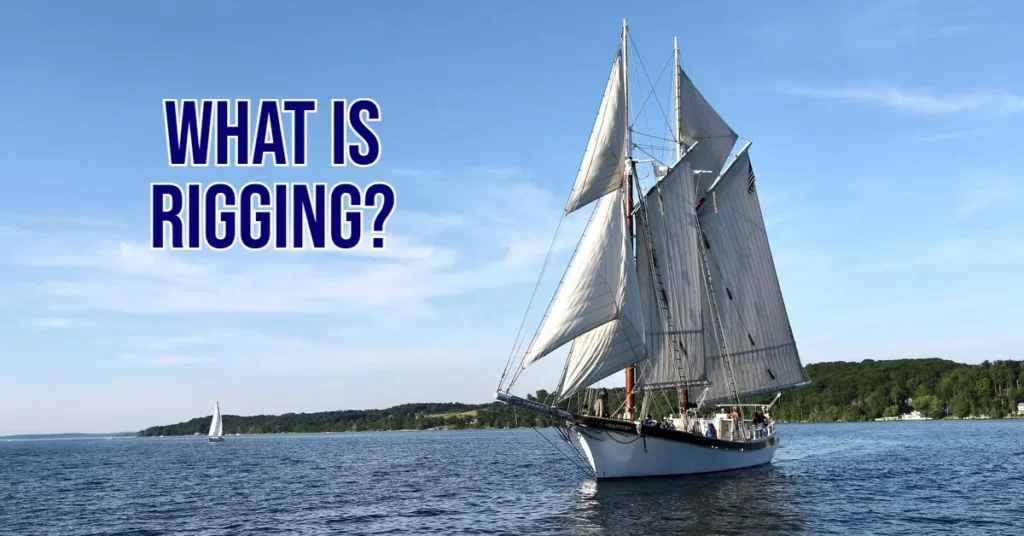
Rigging Modern Ships
The rigging of modern container ships involves loading and securing equipment and cargo before transport. Every vessel has a unique rigging plan that shipyard workers or “riggers” must follow with utmost precision.
A rigging plan is basically a blueprint for lifting and securing heavy loads onto the ship. This blueprint includes the positions, sizes and safe working loads (SWL) of the deck eye plates, runners, guys, twist locks, wedges, chocks, beams, preventers and shackles. Many of these parts are found on traditional sailing ships and play the same role of keeping equipment steady.
Most commercial ships today have all the equipment they need already on board. As such, shipping companies try to avoid unrigging the equipment to improve their shipping efficiency and save more time between voyages. However, they still require rigging when loading fresh cargo or if something needs to be repaired or replaced.
The shackles — also known as “gyves” — are the key pieces of the rigging puzzle. They are responsible for connecting the crane or forklift to the load, which means they must be durable. Industrial shackles used for shipping, manufacturing and other industrial applications are made exclusively of steel , whether galvanized, alloy, carbon or stainless.
Cranes and front-loading and side-loading forklifts are the primary machines used to load cargo, but sometimes specialized machinery is required. Riggers might have to use top handlers, side handlers, straddle carriers, reach stackers or radial telescopic shiploaders. The bigger the ship, the more vehicles are usually required.
As the riggers load the equipment on board, they may have to redistribute the weight so the ship doesn’t lean too far in any direction. One common example of weight redistribution is trimming, in which the riggers shift around dry bulk cargo to help the vessel remain balanced. They may also use different stacking techniques when loading containers on top of each other.
The final step in the rigging process is inspecting the newly repaired or added parts. Inspectors may put the components through nondestructive testing to ensure they meet industry standards and the vessel’s specifications. The crew must also confirm that every piece of cargo or equipment not directly attached to the ship is secure.
Rigging Traditional Sailing Ships
While rigging is a verb when referring to modern cargo and container ships, it becomes a noun when referencing traditional sailing ships. A vessel’s rigging consists of the ropes, cables, and chains that support and control the masts and sails. Preparing these parts for a long voyage involves various tasks depending on the vessel’s size and shape.
For older square-rigged boats, the sails are rigged from side to side. For newer boats, the sails are rigged from front to back — also known as fore-and-aft. Ships with fore-and-aft rigs quickly became the most common option once sailors realized the triangular sails could point higher into the wind and offered more maneuverability.
One or two experienced people can easily assemble a sailboat’s rigging for personal use. The first task is to install the rudder, which is the steering apparatus that attaches to the stern. The next attachment is the tiller, a long, thin steering arm that connects to the rudder for better control.
With the rudder and tiller in place, it’s time to focus on the sails. Unlike modern cargo ships that can keep all their equipment on board, sailboats must have their sails removed after each voyage to avoid getting damaged. Putting the sails back on the boat is called “bending on” because the crew must bend them into place.
The next item that gets attached is the jib halyard shackle, which connects to the top corner of the sail or the head. The grommet attaches to the front bottom corner of the sail, also known as the tack. The grommet and tack are then shackled to the fitting at the bottom of a piece of standing rigging called the forestay.
The next step’s difficulty largely depends on the wind. If it’s a calm day, one person can easily attach the jib halyard to the forestay. This step is called “hanking” because you need to clip the hanks — the spring-loaded iron rings that keep the sales in place — onto the forestay. There must not be any twists or creases in the sail as it slowly gets raised into position.
When all the hanks are attached to the forestay, the jib sheets are secured to the sail’s clew. All these preparations are required before rigging the mainsail. The mainsail connects to the main halyard, which is almost the same as attaching the jib halyard. The main halyard also serves as a topping lift on smaller sailboats to keep the mast’s boom in place.
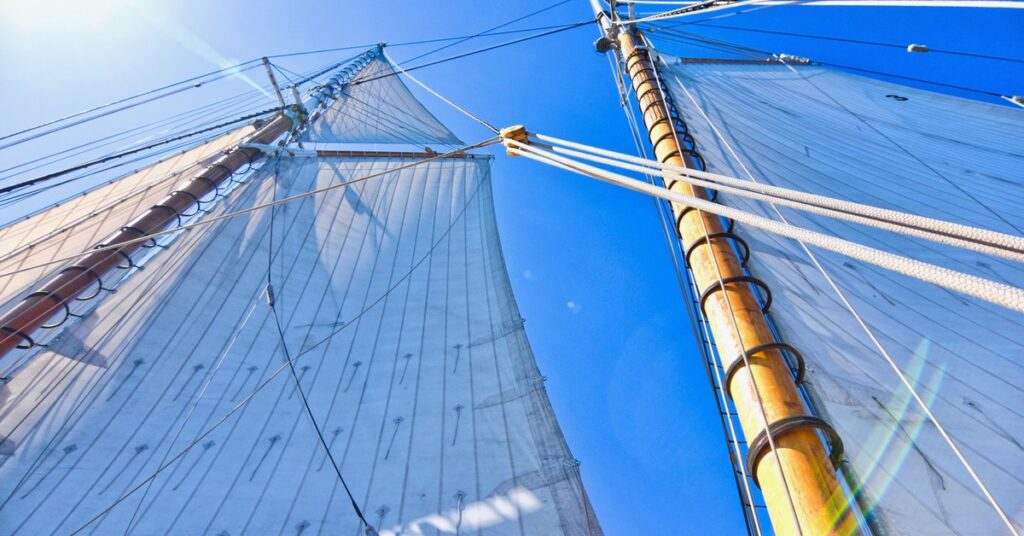
The mainsail gets secured to the boom at three points — the luff, clew and foot. The luff is the leading edge, the clew is the front lower corner and the foot is the bottom edge. For some boats, the foot doesn’t attach to the boom and instead gets drawn tightly so it doesn’t move. These boats are called loose-footed sailboats.
Finally, the mainsail is attached to the mast with a bolt rope or “slugs” that are evenly spaced on the luff. Continue raising the mainsail and inserting each slug. When the mainsail is all the way up, pulling on the halyard creates more tension in the luff and keeps the sail in place. Then, the halyard gets tied to the cleat hitch so everything is secure.
As evidenced by the complex terminology and detailed steps, rigging a full-size sailboat for commercial use is a lot of work. Plus, the crew must account for the ship’s unique sail structure. Sailboats can have multiple types of rigging that require special steps for assembly. Here’s a detailed breakdown.
- Standing Rigging
Standing rigging refers to the lines, wires and rods that remain in a fixed position. These components are almost always located between the mast and main deck. Their tension helps the mast stay in place and prevents it from swaying. Standing rigging used to be made of tar-coated rope, but today, it’s made of steel cables.
- Running Rigging
Running rigging includes the cordage that controls the sails’ positioning. The halyards raise the sails and regulate their tension, while the outhaul, downhaul and clew regulate the sail’s shape. Sheets and braces control the sail’s orientation to the wind. Manilla rope was historically the material of choice, but now ropes with synthetic fibers are more common.
- Sloop Rigging
Sloop rigging consists of a single mast with a triangular mainsail and jib. It’s a common arrangement on sailboats from small dinghies to large commercial cruisers. Beginner sailors often choose boats with slope rigging because of their simple layout. It dates back to the 1600s when European sailors perfected the design.
- Cutter Rigging
Cutting rigging has a similar layout to sloop rigging, but it has an additional headsail that provides extra control over speed and direction. The headsail is smaller than the mainsail and jib so one person can control it if necessary. It’s a great choice for longer voyages and journeying through heavy winds.
- Ketch Rigging
Ketch rigging consists of two masts instead of one, which is common on larger sailboats. The main mast is standard size, but the mizzen mast near the rudder is smaller. Both are triangular in shape. Ketch rigging is highly versatile because the sail connected to the mizzen mast can be taken down if necessary.
- Yawl Rigging
Yawl rigging is similar to ketch rigging, but the mizzen mast is closer to the bow for more control. The slight change in mast location offers more control over the boat’s direction in heavy winds. Again, the mizzen mast’s sail doesn’t have to be used. The crew can always lower it and effectively return to a sloop rigging design without missing a beat.
There are many other outdated or little-used rigging types, including lateen, gaff, junk, gunter, settee and crab claw rigging. These configurations are no longer popular for one of two reasons. Either they utilized square sails instead of triangular sails or they relied on freestanding masts, which are unstable without extra standing rigging.
Rigging Comes in Many Forms
Rigging comes in many forms. It means something entirely different for modern cargo ships and traditional sailboats. For engine-powered vessels, rigging refers to the loading and securing of equipment. For sailing ships, rigging refers to the various ropes, cables and other devices that connect the masts and sails. In both cases, many subcategories and technical terms are underneath the surface.
Frequently Asked Questions
What does rigging mean.
Rigging can mean several things depending on the vessel in question. For modern engine-powered ships, rigging simply means loading and securing equipment or cargo. For traditional sailboats, rigging means the various components that connect the sail and mast and allow the boat to navigate.
What is the rigging process of a cargo ship?
Rigging a cargo ship includes a plan that maps out all the ship’s components that hold equipment or cargo in place. Shipyard workers, or riggers, load the equipment to the plan’s exact specifications and utilize different storage or weight distribution methods. The final step is an inspection, which may include nondestructive testing for compliance.
What is the rigging process of a sailboat?
The rigging process of a sailboat has many more steps. For a simple vessel, the crew has to install or connect the rudder, tiller, jib and mainsail. Each part requires careful precision because the sails can’t be twisted, creased or unstable.
Which sails are best for rigging?
Historically, square sails were the most popular ones to rig on ships. However, triangular sails have become the dominant shape because they can catch the wind at a higher point, giving the crew more control over the vessel.
What are the different types of rigging?
There are many different types of rigging. For starters, every sailboat has standing and running rigging. Standing remains stationary, while running moves around and controls the positions of the sails. Other common types include sloop, cutter, ketch and yawl.
- Recent Posts
- How Old Do You Have to Be to Drive a Boat? – November 12, 2024
- The Engineering Behind Ice-Class Vessels – September 20, 2024
- Is Maritime Security Necessary on Modern Ships? – September 11, 2024
Latest Posts
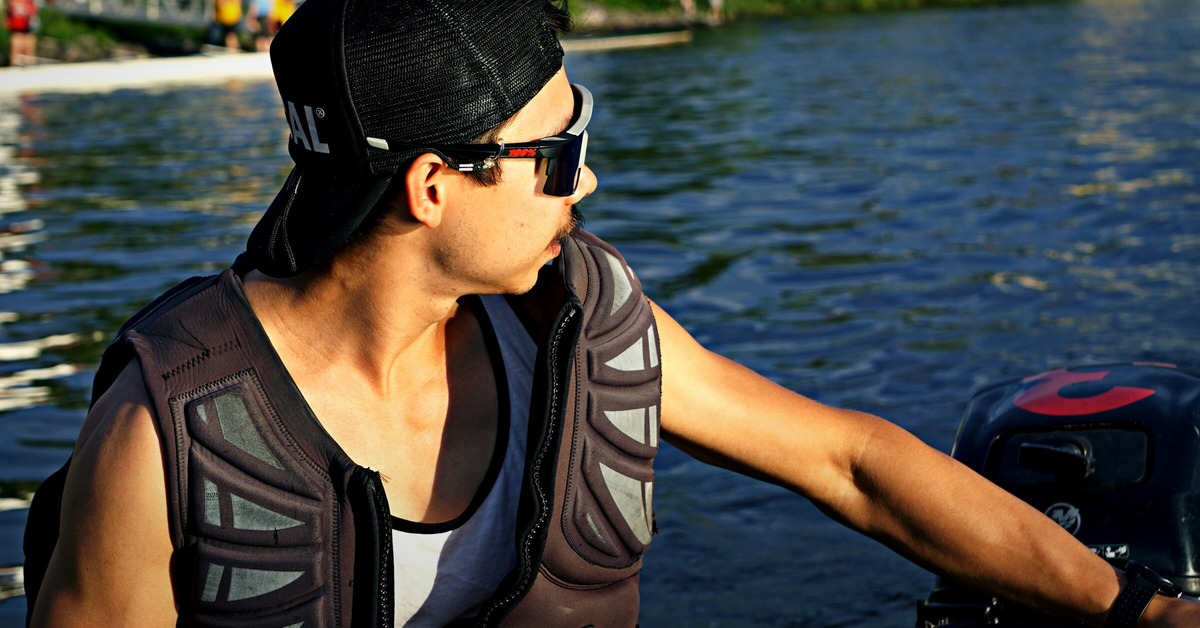
How Old Do You Have to Be to Drive a Boat?
How old do you have to be to drive a boat? The age requirements for boat operation are more complex than expected, with variations across jurisdictions and vessel types.

LNG vs. LPG: A Comprehensive Guide to the Difference between LNG and LPG
LNG and LPG play vital roles in maritime transport. Learn about their unique storage, transport methods, and how each fuel impacts shipping efficiency and sustainability.

Cargo Handling Systems and Equipment on Oil Tankers
Learn about oil tanker cargo systems, from pumps to safety alarms, ensuring safe oil transfer, storage, and handling through regulated procedures and equipment.
- Types of Sailboats
- Parts of a Sailboat
- Cruising Boats
- Small Sailboats
- Design Basics
- Sailboats under 30'
- Sailboats 30'-35
- Sailboats 35'-40'
- Sailboats 40'-45'
- Sailboats 45'-50'
- Sailboats 50'-55'
- Sailboats over 55'
- Masts & Spars
- Knots, Bends & Hitches
- The 12v Energy Equation
- Electronics & Instrumentation
- Build Your Own Boat
- Buying a Used Boat
- Choosing Accessories
- Living on a Boat
- Sailboat Cruising Tips for Beginners
- Sailing in the Caribbean
- Anchoring Skills
- Sailing Authors & Their Writings
- Mary's Journal
- Nautical Terms
- Cruising Sailboats for Sale
- List your Boat for Sale Here!
- Used Sailing Equipment for Sale
- Sell Your Unwanted Gear
- Sailing eBooks: Download them here!
- Your Sailboats
- Your Sailing Stories
- Your Fishing Stories
- Advertising
- What's New?
- Chartering a Sailboat
Sailboat Rigging: Part 1 - Standing Rigging
When we talk about sailboat rigging, we mean all the wires, ropes and lines that support the rig and control the sails. To be more precise, the highly tensioned stays and shrouds that support the mast are known collectively as standing rigging , whilst the rope halyards, sheets and other control lines come under the heading of running rigging.
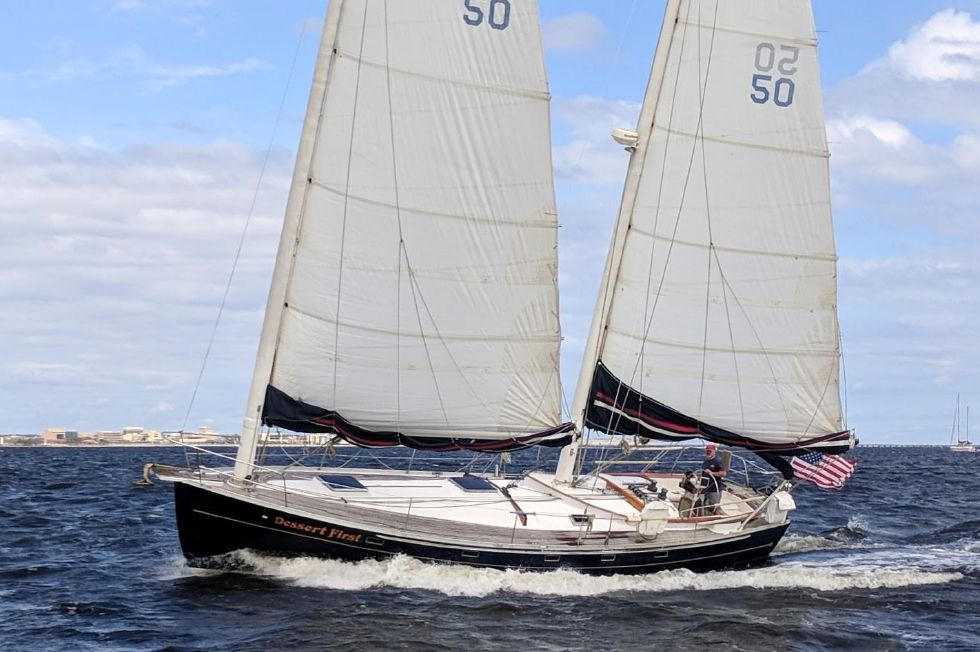
Some sailboats with unsupported masts, like the junk rig and catboat rigs have no standing rigging at all.
Bermudan sloops with their single mast and just one headsail will have a relatively simple rigging layout - those with a single set of spreaders especially so.
The most complex rigging of all will be found on staysail ketches and schooners with multi-spreader rigs.
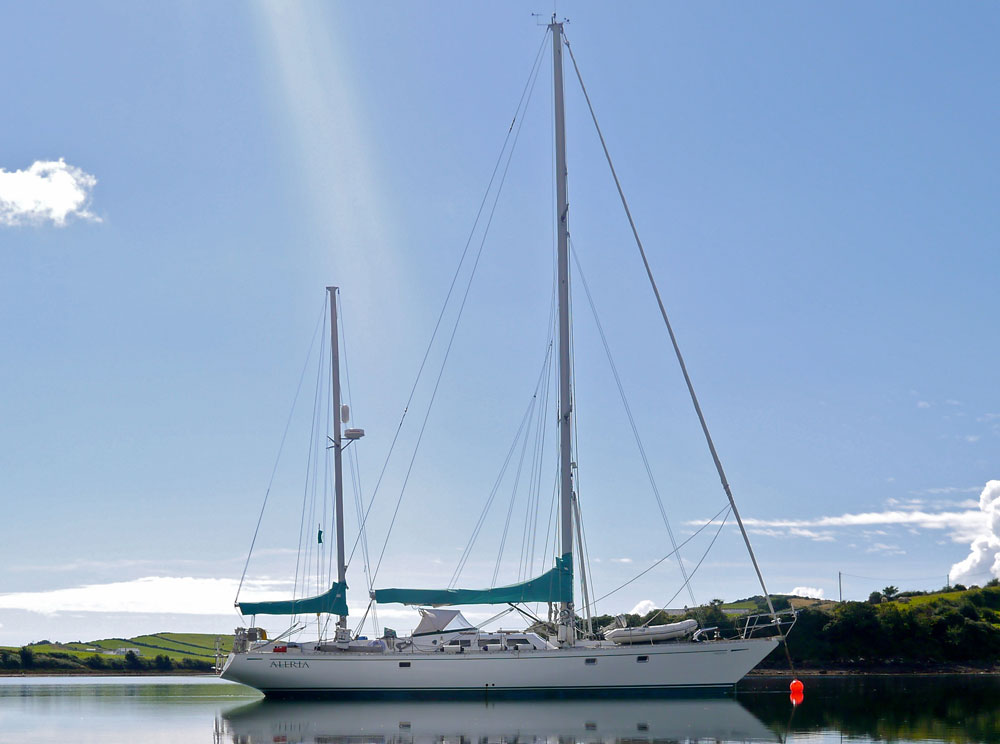
Fairly obviously, the mast on a sailboat is an important bit of kit.
Let's make a start by taking a look at the standing rigging that holds it up...
Standing Rigging
Cruising sailboats will have their mast supported by 1 x 19 stainless steel wire in most cases, but some racing boats may opt for stainless steel rod rigging. Why? Well rod rigging has a stretch coefficient that is some 20% less than wire, but...
- It's more expensive than wire;
- It's more difficult to install and adjust;
- It suffers from metal fatigue, signs of which are difficult to spot;
- It's less flexible and has a much shorter useful life span
So it's 1 x 19 stainless steel wire for us cruising types.
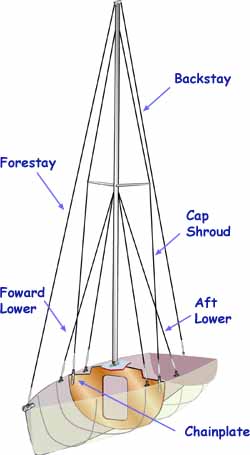
Cap Shrouds
These are the parts of a sailboat's rigging that hold the mast in place athwartship. They're attached at the masthead and via chainplates to the hull.
Lower Shrouds
Further athwartship support is provided by forward and aft lower shrouds, which are connected to the mast just under the first spreader and at the other end to the hull.
The mast is supported fore and aft by stays - the forestay and backstay to be precise.
Cutter rigs require an inner forestay upon which to hang the staysail, which unlike a removable inner forestay, becomes an element of the overall rig structure.
As this stay exerts a forward component of force on the mast, it must be resisted by an equal and opposite force acting aft - either by swept-back spreaders, aft intermediates or running backstays.
Another stay that deserves a mention is the triatic backstay. This is the stay that is found on some ketches, and it's the stay from the top of the mainmast to the top of the mizzen mast.
It's a convenient alternative to a independent forestay for the mizzen. Although it makes a great antenna for an SSB radio , it does ensure that if you lose one mast, you're likely to lose the other.
Multi-Spreader Rigs
With the lower shrouds supporting the mast athwartship at the lower spreaders, intermediate shrouds do the same thing for any other sets of spreaders. These take the form of a diagonal tie between the inner end of one spreader and the outer end of the spreader below it.
Continuous or Discontinuous Sailboat Rigging
The shrouds on all single-spreader rig and some double-spreader rigs are continuous. With three or more spreaders, this arrangement becomes impractical - discontinuous rigging is the way to go. So what's that?
Well, if you consider the mast rigging as a series of panels, ie:~
- Lower Panel ~ From the deck to the first set of spreaders;
- Top panel ~ From top set of spreaders to the masthead;
- Intermediate Panels ~ Between each set of spreaders.
Then discontinuous rigging is when each shroud is terminated at the top and bottom of each panel.
The main benefits of discontinuous sailboat rigging is:~
- The rig can be more accurately set up, and
- Weight aloft is substantially reduced;
- It can be replaced in small doses.
Chainplates, Turnbuckles and Toggles
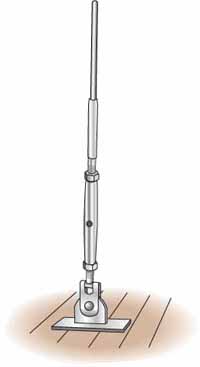
It's through these vitally important sailboat rigging components the shrouds are attached to the hull.
The chainplate is a metal plate bolted to a strongpoint in the hull, often a reinforced section of a bulkhead.
It must be aligned with angle of the shroud attached to it through a toggle, to avoid all but direct tensile loads.
Whilst cap shrouds will be vertical - or close to it - lower shrouds will be angled in both a fore-and-aft direction and athwartship.
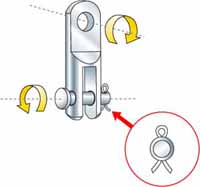
Artwork by Andrew Simpson
Toggles are stainless steel fittings whose sole purpose in life is absorb any non-linear loads between the shrouds and the chainplate.
Consequently, they must be of a design that enables rotation in both the vertical and horizontal planes.
Note the split pin! These are much more secure than split rings which can gradually work their out of clevis pins - with disastrous results.
Turnbuckles, or rigging screws or bottlescrews, are stainless steel devices that enables the shroud tension to be adjusted.
Next: Part 2 - Running Rigging
Read more about Reefing and Sail Handling...
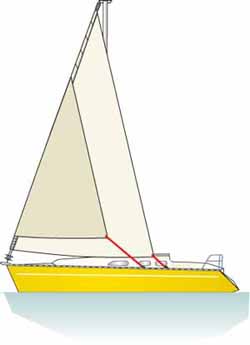
Headsail Roller Reefing Systems Can Jam If Not Set Up Correctly
When headsail roller reefing systems jam there's usually just one reason for it. This is what it is, and here's how to prevent it from happening...
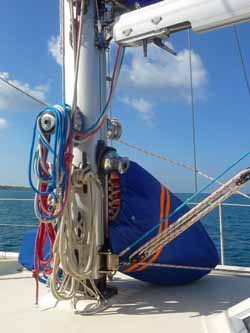
Single Line Reefing; the Simplest Way to Pull a Slab in the Mainsail
Before going to the expense of installing an in-mast or in-boom mainsail roller reefing systems, you should take a look at the simple, dependable and inexpensive single line reefing system
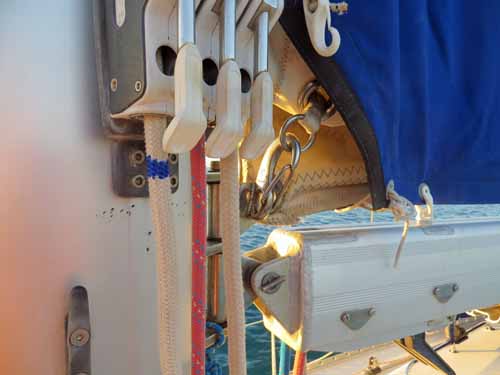
Is Jiffy Reefing the simplest way to reef your boat's mainsail?
Nothing beats the jiffy reefing system for simplicity and reliability. It may have lost some of its popularity due to expensive in mast and in boom reefing systems, but it still works!
Recent Articles
The Cabo Rico 38 Sailboat
Dec 07, 24 08:40 AM
Pearson 33 Sailboat Specs & Key Performance Indicators
Dec 06, 24 03:38 AM
Windship 60 Sailboat Specs & Key Performance Indicators
Dec 05, 24 06:44 AM
Here's where to:
- Find Used Sailboats for Sale...
- Find Used Sailing Gear for Sale...
- List your Sailboat for Sale...
- List your Used Sailing Gear...
Our eBooks...

A few of our Most Popular Pages...
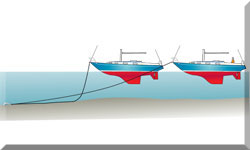
Copyright © 2024 Dick McClary Sailboat-Cruising.com

IMAGES
COMMENTS
The difference between standing rigging and running rigging. Sometimes things can get confusing as some of our nautical terms are used for multiple items depending on the context. Let me clarify just briefly: The rig or rigging on a sailboat is a common term for two parts:. The standing rigging consists of wires supporting the mast on a sailboat and reinforcing the spars from the force of the ...
The domain of rigging is an essential matter for the safety and good performance of your sailboat. Nowadays, the type of rigging is still evolving. Generally, rigging is depending on the type of sail used or the number of masts. As a basic rule, the replacement of the standing rig should be done every 10 years, except for multihulls or regattas, and rod or composite fiber rigging. A good set ...
Rigging comprises the system of ropes, cables and chains, which support and control a sailing ship or sail boat's masts and sails. Standing rigging is the fixed rigging that supports masts including shrouds and stays. Running rigging is rigging which adjusts the position of the vessel's sails and spars including halyards, braces, sheets and ...
Some types of sailboat rigging don't use a topping lift for their boom but a boom vang instead. Others have both! Topping lifts can also be used to lift other spars. Downhaul. A downhaul is a line used to lower with and typically used to haul the mainsail down when reefing and lowering the spinnaker and whisker poles. The downhaul can also ...
The running rigging is the rigging on a sailboat that's used to operate the sails. For example, the halyard, which is used to lower and heave the mainsail. The standing rigging is the rigging that is used to support the mast and sail plan. Standing Rigging. Here are the different parts that belong to the standing rigging:
A sailboat's standing rigging is generally built from wire rope, rod, or occasionally a super-strong synthetic fibered rope such as Dyneema ®, carbon fiber, kevlar or PBO. 1×19 316 grade stainless steel Wire Rope (1 group of 19 wires, very stiff with low stretch) is standard on most sailboats.
Sailing is a thrilling experience, offering a unique blend of adventure, relaxation, and connection with nature. Central to this experience is the sailboat's rigging system, a complex network of ropes, wires, and chains that control the sails and mast.
Sailboat rigging is the collective system of ropes, wires, pulleys, and other equipment used to control the sails and other parts of a sailboat. It is an essential component of sailing, and proper rigging can make a huge difference in the performance of a boat. Rigging is used to adjust the shape and orientation of the sails to the wind, which ...
Rigging Traditional Sailing Ships. While rigging is a verb when referring to modern cargo and container ships, it becomes a noun when referencing traditional sailing ships. A vessel's rigging consists of the ropes, cables, and chains that support and control the masts and sails. Preparing these parts for a long voyage involves various tasks ...
Continuous or Discontinuous Sailboat Rigging. The shrouds on all single-spreader rig and some double-spreader rigs are continuous. With three or more spreaders, this arrangement becomes impractical - discontinuous rigging is the way to go. So what's that? Well, if you consider the mast rigging as a series of panels, ie:~